Since 1992, the Bouvet Ladubay Contemporary Art Center one of the first private art venues intended for the public in the west of France has been celebrating contemporary creation in all its diversity. In its 30 years of existence, it has steadfastly presented works by nearly 100 artists who made and who continue to make the art of our time.
1992
Bernard Aubertin, César, Olivier Debré, Claude Gilli, Peter Klasen, Loïc Le Groumellec, Jean-Paul Marcheschi, François Morellet, Patrick Raynaud
From the very first exhibition, we wanted to define the path we would take. The guiding idea was to organise events dedicated to the artistic production of our time.
My goal was to present a large panel of this creative work, without restricting myself to a particular movement or a defined medium. We did not limit ourselves to artists from the region and we exhibited national and international artists. I am particularly grateful to those who participated in the first exhibition and who gave the kick-off to this new cultural space.
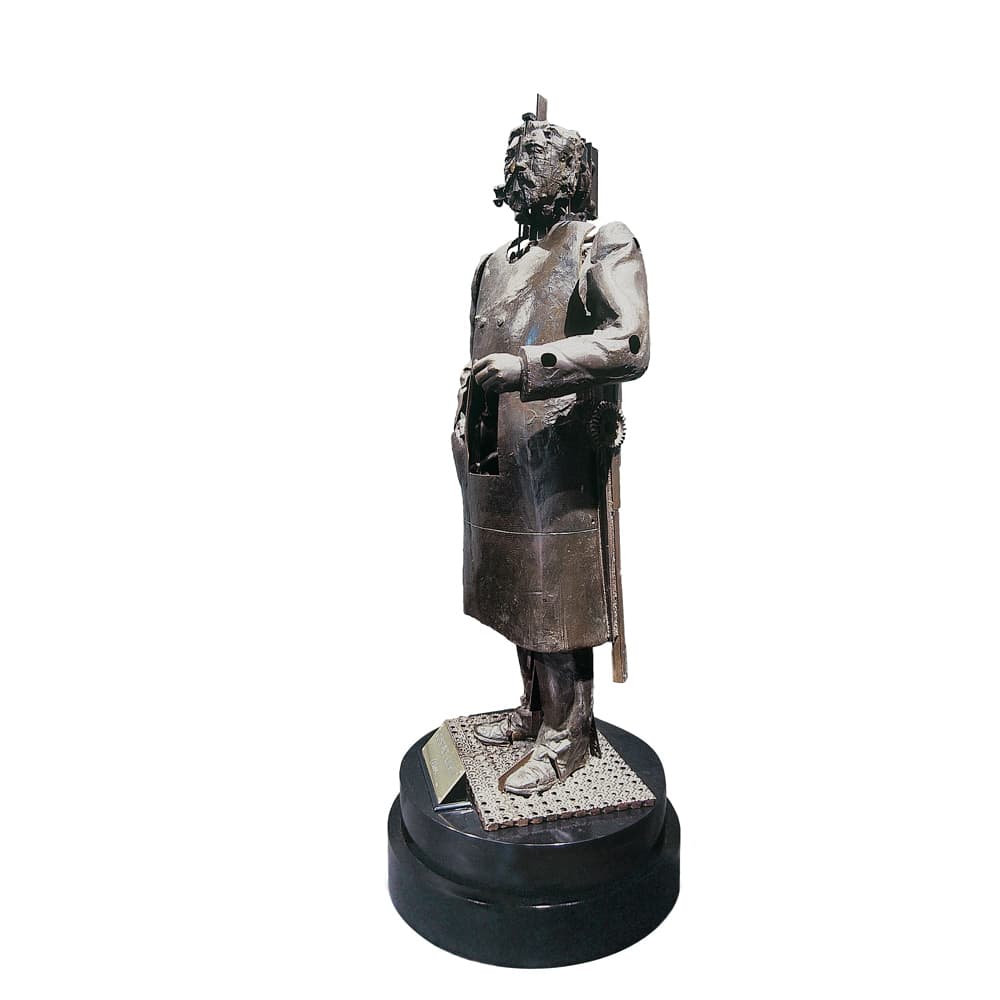
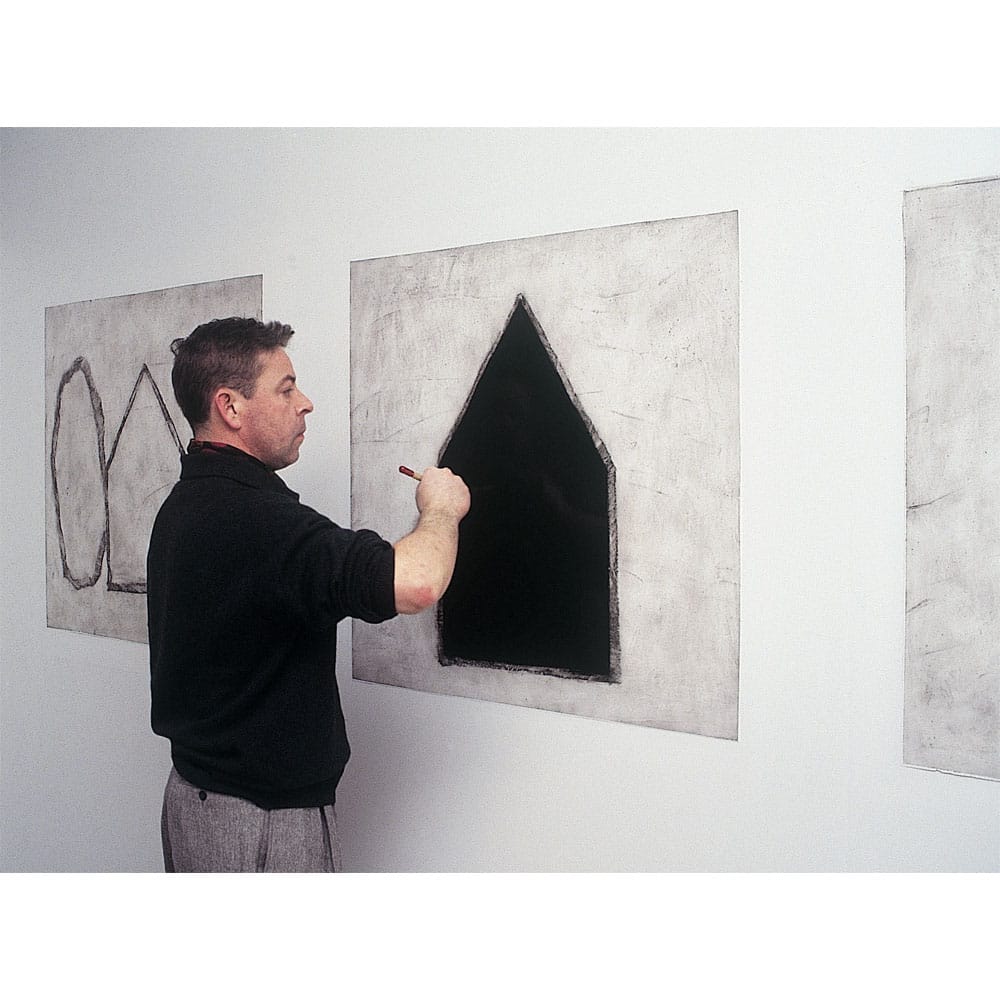
Loïc Le Groumellec

François Morellet
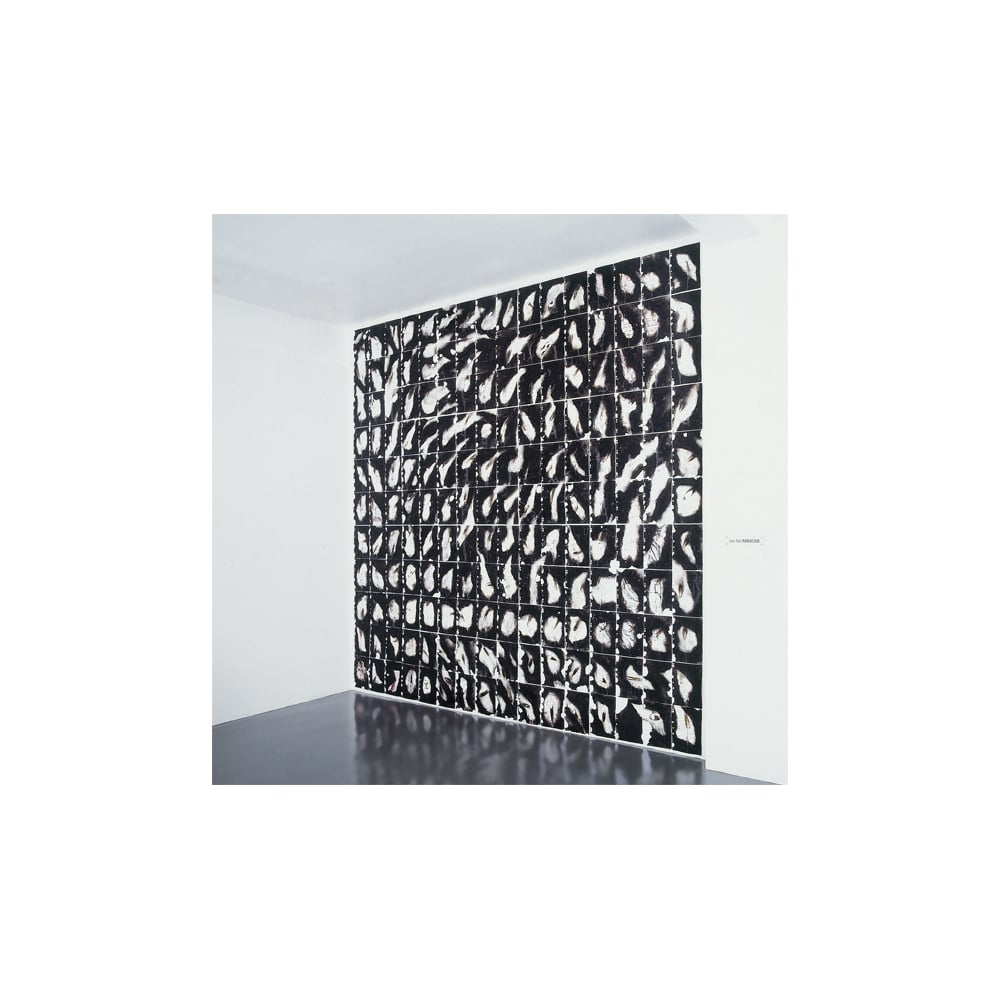
Jean-Paul Marcheschi

Peter Klasen

Patrick Raynaud
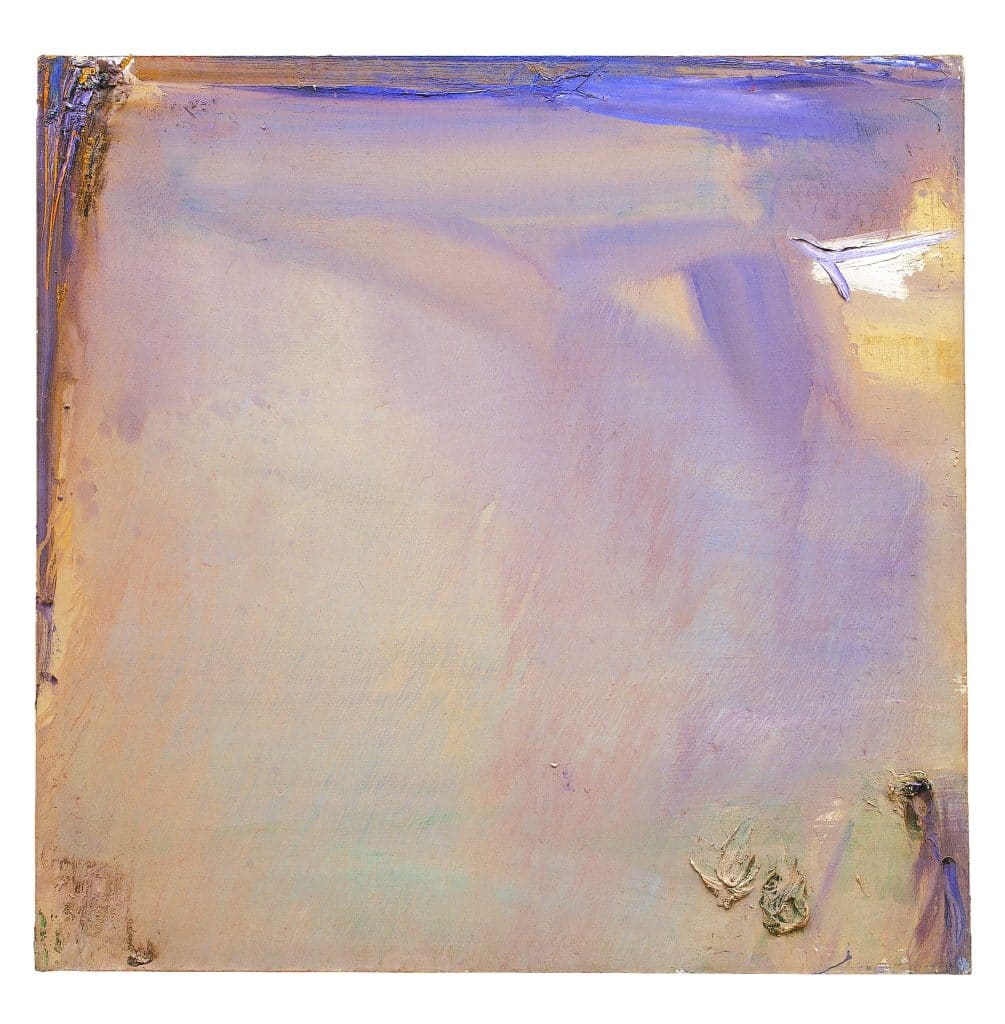
Olivier Debré

Jean-Paul Marcheschi
1993
The 1993 spring exhibition features works by artists who are well known for their figurative work.
The narrative figuration artistic movement that arose in the early 1960s is represented by Valerio Adami, Erró, Jacques Monory and Bernard Rancillac.
The young, free figuration generation, a group of artists from the 1980s, very much in the media spotlight, is represented by Robert Combas and Hervé di Rosa.
A rich and colorful dialogue between two generations.
Christian Astuguevieille, Alain Balzac, Jean-Michel Basquiat, Gérard Deschamps, Federica Matta, Bernar Venet, Claude Viallat
Plasticity, power and colour are in the spotlight in this seasonal event. The confrontations are multiple. Nouveau Réalisme looks at Support/Surface and the works of Gérard Deschamp allude to Claude Viallat’s paintings. Conceptual art interconnects ideas with the underground and Bernar Venet’s sculptures stand next to Jean-Michel Basquiat’s large-format paintings. It is energy that triumphs. The Bouvet Ladubay Contemporary Art Center is animated by a rebellious spirit. With this autumn exhibition, it proves how much it is committed to showing contemporary creation in all its diversity.
Extract from the press release of the exhibition
1994
1934, Lesko (Poland) – 2021, Angers (France)
I paint and remove what I have painted. In addition, I glue beforehand so that I can peel off what has been painted. I discover this image myself and that’s what counts: this incomplete image – unique, accepted by me.
That’s enough for me, personally. There is a certain mysticism to this attitude.
Edward Baran
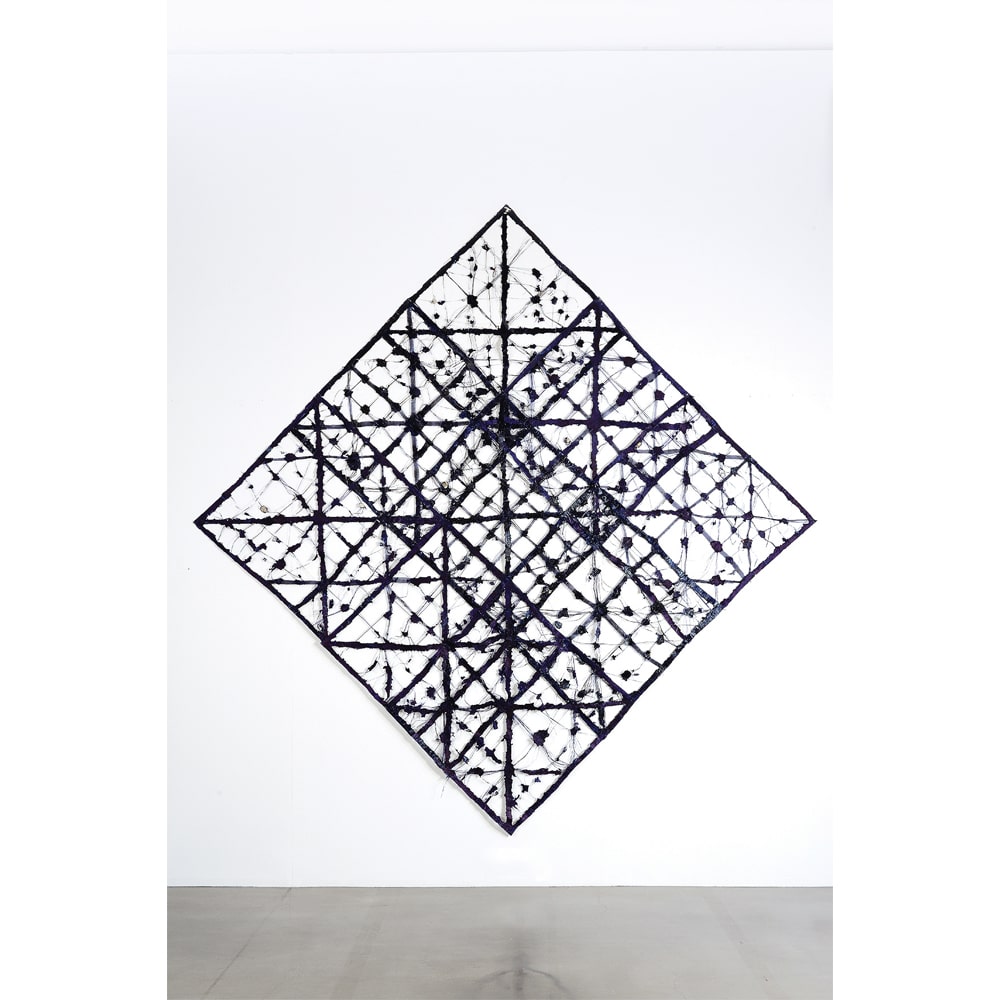
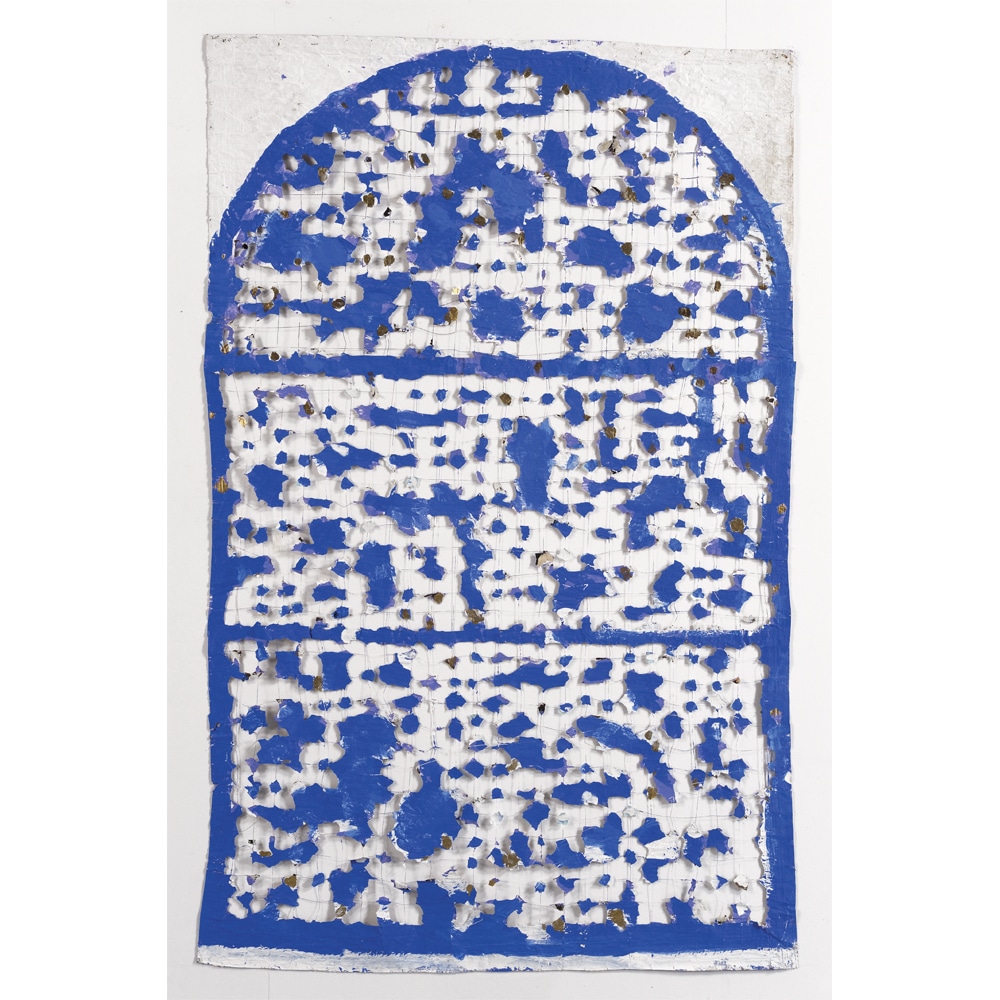
The Bouvet Ladubay Art Center 1994 summer exhibition welcomes the talents and inspirations of artists from many different geographical backgrounds (France, Poland, Switzerland, Germany) who have chosen to live and work in France. The works of these creators, with very different artistic and theoretical paths, offer an exceptional range of emotions. Niele Toroni’s minimalism, Roman Opałka’s conceptual art, Olivier Debré’s lyrical abstraction, Peter Klasen’s narrative figuration and Christian Renonciat’s hyperrealism converse powerfully and offer a very singular formal journey.
Extract from the press release of the exhibition
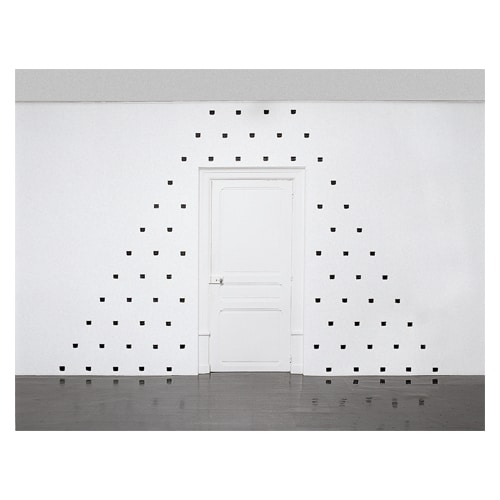
Niele Toroni, Work produced in situ

Roman Opalka

Niele Toroni, work produced in situ
1929, Barcelona – 2011, Saint-Mathurin-sur-Loire (France)
The object with its experience is the starting point for an artwork that can become poetic, dramatic or ironic. It will always depend on the way it is handled and presented. The artist’s work is carried out alone in a concrete historical context; it is a permanent compromise that he must bring to a conclusion, so the free artist is offered all the material and conceptual means he considers valid to try to approach this. This is how he can undoubtedly add his link to the chain of art history. Whether he is understood sooner or later, without excluding that he may never be…
Josep Grau-Garriga
1995
1947, Paris – Lives and works in Touraine.
What interests me is not the representation of familiar objects, an allusion to everyday life that I made without knowing it; it is this work on the surface, on the tender skin of the wood, to make it say something else, an interior, an intimacy that is not its own, but that the body knows well, so that the body can recognise itself in every moment. Behind the disturbing (and very short) effect of the “trompe-l’oeil”, there is the pleasure, for everyone, of feeling and recognising in his or her body a memory, a sensation, a whole unsuspected world, a culture even, that our education makes us forget or neglect.
Christian Renonciat
In 1969, Jean-Pierre Pincemin and Claude Viallat organised an exhibition at the École Spéciale d’Architecture in Paris. The artists participating in this exhibition would be the core of the Support/Surface group. […] Jean-Pierre Pincemin instead took a path where classicism (generic term) was the designated goal.
His painting’s sophisticated chromatism organised by a rigorous construction made him an inimitable artist – French tradition dictates – impersonality, austerity, expression and restrained feeling.
A cerebral sensuality!
In 1986, he modified his way of painting and his conception of space. We would then be dealing with expressionist and imaginative constructions to arrive at principles which are those of figurative painting.
Monkey Business
This summer, the Bouvet Ladubay Contemporary Art Center brings together some strong personalities! Nice artist Ben with his famous calligraphy offers black and white paintings with explicit messages. Guy de Rougemont flies his flag with large-format paintings and painted wood sculptures. Richard Texier fills the space with his creations in bronze, wood and marine ropes. Bernard Gitton, inventor of the water clock, shows time that flows drop by drop. Christian Renonciat reveals the surface of wood in a sensual gesture that calls for a caress. Jean-Pierre Pincemin imagines forms in his own way with great pictorial mastery. The dazzling white space of the Art Center becomes the precious setting for this abundance of expression.
Extract from the press release of the exhibition
Paul Jenkins’s art lies at this junction of a huge world where the creator tries, by all the means in his possession, to restore, if possible, an individuality and a place to the painting of today, from dissociated elements and cultures, now recomposed. […] The artist experiences the constraints of the space that surrounds him, but also the conflicts of the soil from which he comes. The confrontation of these two worlds is not a rupture, but a reconciliation of elements that combine in an inescapable way, to say that everything is still possible.
Jean-Louis Prat, Saint-Paul
1996
1955, Niort, France –
Lives and works in Paris
Works from the 90’s
To express his universe full of mutations and metamorphoses, Richard Texier recreates a poetic image of the world in his own way, using techniques as varied as painting, sculpture and engraving.
Texier draws his material from the jottings of the first astronomers and the cosmogony of the great explorers. His works are so many lands that he explores, portolan charts that he imagines. They are visual and receptive answers to the questions of humankind lost in the universe, trying to organise and understand the signs that the world places at its disposal, to spread its wings and experience the great human epic and to arouse the mystery of the world.
Extract from the Art Center’s 10th anniversary book
1925, Alexandria, Egypt – 2018, Paris
He can, in this same fabric of modern hieroglyphs, evoke, with his post-naturalist or post-pointillist truth, a landscape seen in its optical reality, exact but transcended, or (and this is one of his current preoccupations until some new invention), translate into pictorial terms poems from various authors, from the most famous to the most recent. In short from Baudelaire to Apollinaire or from Mallarmé to Frénaud, from Bonnefoy to… Here I dare not mention my name, although I owe him the honour of having dedicated to me a series of tremendous canvases […] It is as if by painting my texts with his brush, he added an extra meaning and pungency to them.
Jean Tardieu, 7 February 1994, Paris
Works on paper
Valerio Adami, Eduardo Arroyo, Robert Combas, Marco Del Re, Michel Haas, Christian Renonciat
For the summer exhibition at the Bouvet Ladubay Contemporary Art Center, I wanted to bring together six artists around the theme of the figure. These painters and sculptors were chosen because of the great diversity of their artistic practices, thus establishing a rich and constructive dialogue.
In addition to the central focus of the figure, the works exhibited all have in common that they were created on paper. The exhibition presents collages by Edouardo Arroyo, gouaches by Marco Del Re and Valerio Adami, ink drawings by Robert Combas, Michel Haas’ torn paper works and Christian Renonciat’s technical drawings.
1926, Quimper, France – 2022, Paris
Retrospective 1955 – 1992
During the 1980s, unauthorised billboard pasting started competing with the organised Parisian billboard companies. Billboard professionals, together with municipal councillors, agreed to strictly enforce the latest law (1979) regulating their profession.
Unauthorised billboards, which had become for me the richest material, were therefore forced to be displayed on the outskirts of Paris, which was undergoing major changes. Rogue posters mainly went up on the roads used by truckers. Hence the subjects – 3615 Minitel Rose which were sex chatlines in GÉNÉRATION FRISSON – in this poster peeled off a billboard in the former Renault factory district.
Jacques Villeglé
1997
1950, Roma – 2019, Paris
Recent works 1990-96
Marco Del Re’s work combines the iconography of modernity with the memory of art history. In it we find traces of Matisse, Braque and Picabia but always warped, transposed and remodelled. He plays with colours that he harmonises or confronts with the natural tint of the paper. His art can be seen as families of paintings focussed on certain figures: pyramids, terraced blocks, spirals and prisms for the works completed around 1980. Vases, fruit bowls, cups, birds, fish, African statues more recently. Over the years, he has developed series of paintings around certain iconographic themes. Often the history of a family of paintings is subdivided into a limited number of large canvases and a much larger production of drawings sketched quickly on paper.
Extract from the Art Center’s 10th anniversary book
1936, Alès, France –
Lives and works in Paris.
L’excursion – Œuvres de 1969 à 1996
The first impression one has when standing in front of Jean Le Gac’s compositions is a mixture of familiarity and strangeness, of the prosaic and the marvellous. One has the feeling of gently breaking into them like a seaside villa tenant exploring the furniture and library shelves of a rented holiday home… All the objects, cameras, postcards, press cuttings, handwritten and typescript texts that we find laid out and arranged in Jean Le Gac’s works become the guarantors of infinite narratives for the reader-spectator.
Jean-Didier Wagneur
Neither truly autobiographical nor nostalgic, Le Gac’s oeuvre, by associating real and imaginary elements, focuses on painting, which is perpetually questioned.
Pascal Bouchaille
1959, Mexico City –
Lives and works in Paris.
“Autres-N@tures”
Miguel Chevalier has acquired a great deal of artistic experience through his multidisciplinary training and his travels around the world.
Since 1982, his art has been characterised by an exploration of today’s technologies. His field of investigation is rooted in art history, whose essential data he reformulates using computer tools.
His themes relate to his observation of the flows and networks that organise our contemporary societies.
He has established himself internationally as one of the pioneers of virtual and digital art. The images he delivers to us perpetually question our relationship to the world.
Extract from the Art Centre’s 10th anniversary book
1998
1955, Montreuil-sous-Bois, France
Lives and works in Montreuil-sous-Bois.
Joël Ducorroy does not show images, he brings them to our attention. Although the artist indicates things, he leaves spectators the freedom, the initiative to visualise them (to make them visible). He leaves it to their imaginations to take them over. He offers us objects of appearance.
He names things, it is up to us to make them exist. Thus his labels do not designate one thing – landscape – but all ‘its possibilities’, all the conceivable, imaginable landscapes. These works become screens (projection planes).
Here appears the playful and humorous dimension of Joël Ducorroy’s oeuvre.
[…] He sows trouble, produces joyful disorder.
Anne Geoffroy
1951, Kyoto, Japan – 2017, Tokyo
Transparences de Mémoire
Light and its materialisation is central to Keiichi Tahara’s artistic approach. This interest constantly oscillates between what he calls white light and black light. The first is the realm of sensations and emotions provoked by the exterior: a landscape illuminated and sculpted by light. The second is an inner light that arouses the imagination and creation thanks to the experiences and knowledge acquired. This light is the light of memories and traces which he has been trying to recreate for some time through his photographs on different media: stone or aluminium… materials that “radiate”. After pure transparency (photographs on glass), he has focused on finding the memory of light through the material.
Extract from the Art Center’s 10th anniversary book
1931, Bäretswill, Switzerland –
Lives and works in Paris and Switzerland.
7 places for a calligraphic metaphor
Anything photographed, no matter how it is made, necessarily has a relationship with the truth of the visible. Whereas painting has always been shown in doubt and uncertainty without ever having a definite point of view, from the beginning, photography has been able to rely on an indisputable basis: reality.
Signes, taches et figures (Signs, Marks and Figures) is the title of one of the twenty-three books shown in Saumur. A clearer statement could not be made about what I call ‘my calligraphies’ and even about my photographs of the last ten years. There are different ways of seeing my work, through their ambiguity, their similarities, the deciphering of each one. I, myself, don’t always know exactly where I’m going.
These signs suggest a man or an object, the trees look at me, they give me a sign; I look at men, they become signs.
Peter Knapp
1999
1936, Hamburg, Germany –
Lives and works in Paris
Jan Voss’s painting, whether considered as a whole or separately, leaf by leaf, gives more than any other the sensation of an internal complicity. A system of echoes and references, of infinite reminders, which makes it an art of memory and which transforms this art of memory, devoid of any rhetoric, into a rustling forest: a treasure hunt in which the erasure of the arrows is part of the work that lays them out.
Jean-Christophe Bailly, extract from “Jan Voss ou la crue des signes” (Repères no. 61)
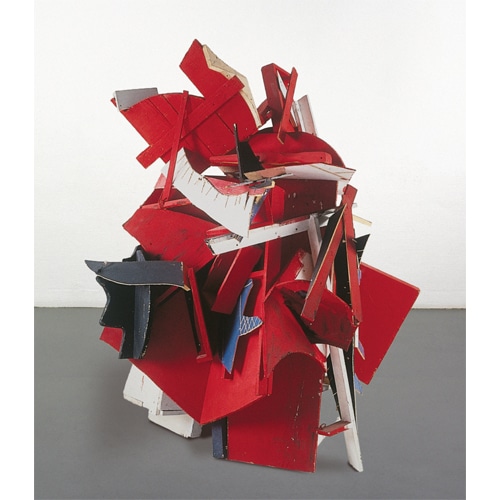
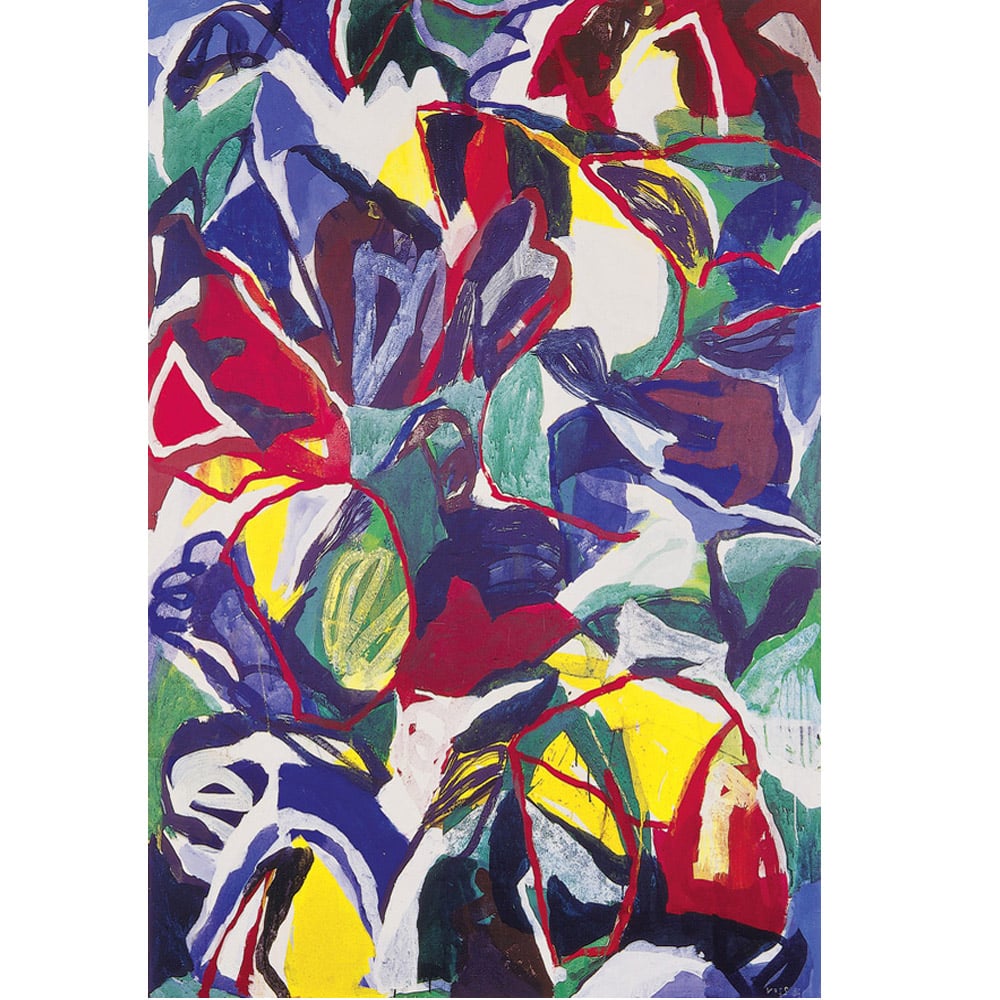
Just as an airy, transparent garment invites the eye and mind to imagine the pattern of what is visible through it, the minimalism and transparency of James Brown’s drawings stimulate the viewer’s imagination and creative participation, while allowing the addition of other materials and techniques to the surface of the work.
This results in drawings of freedom, malleability, movement and flexibility, without unnecessary weight or verbiage.
The artist’s works appeal through the invitation to travel, spiritual elevation and meditation that they express. Outside and inside are now merged into a dimension that is space, a space of energy flow and meditation.
Démosthènes Davvetas
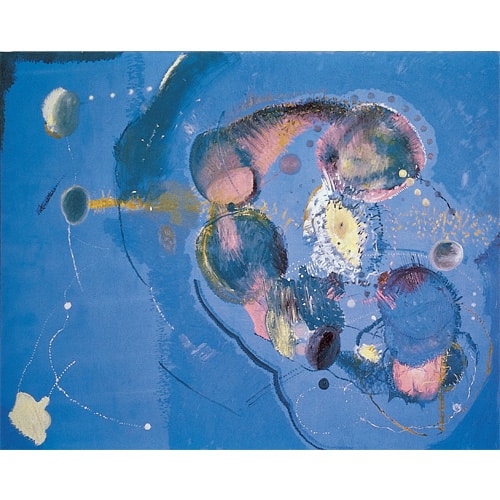
2000
A selection of works from the Frac des Pays de Loire
Cécile Bart, Alan Charlton, Allan McCollum, Pascal Convert, Bernard Frize, Philippe Gronon, Fabrice Hybert, Bertrand Lavier, Loriot et Mélia, François Morellet, Walter Obholzer, Bernard Piffaretti, Georges Rousse, Claude Rutault, Patrick Tosani, James Welling
When Jean-François Taddei, director of the Frac des Pays de la Loire, suggested that we organise an exhibition with works from its collection, we were enthusiastic. It was one of the first times since its creation that the Frac had collaborated with a private venue. This encounter allowed us to conceive Accords Opposés, a temporary exhibition defined around a precise theme, the confrontation between painting and abstract photography, bringing together the works of sixteen artists.

Bertrand Lavier, on the foreground and Niele Toroni in the background

Georges Rousse on the left and Philippe Gronon, on the right
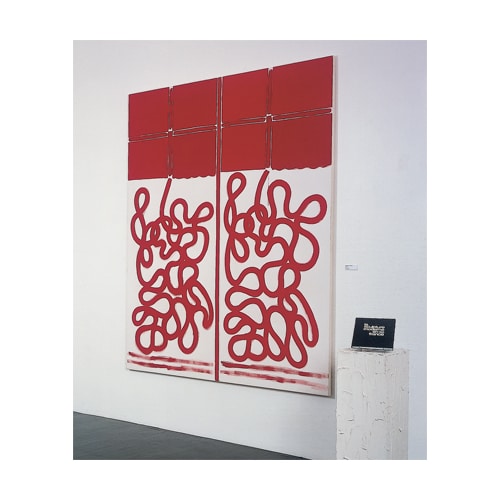
Bernard Piffaretti
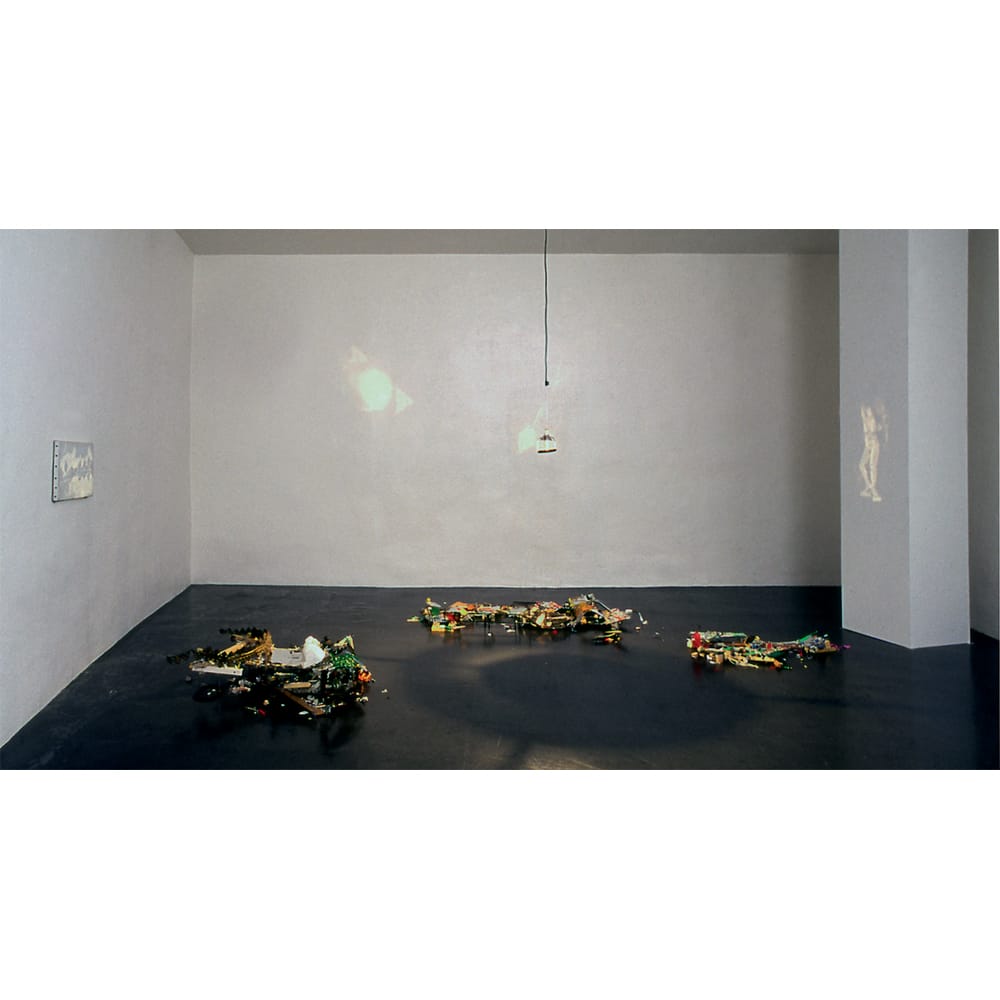
installation de Loriot et Mélia
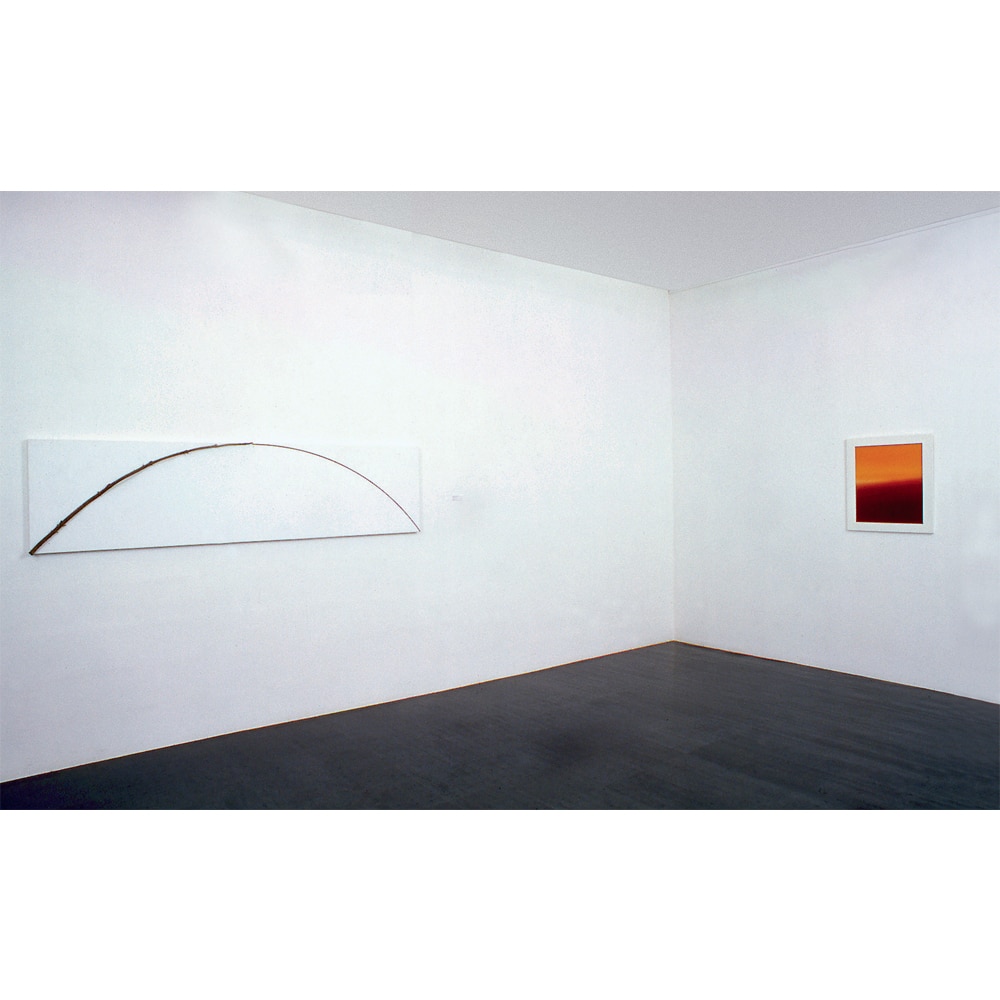
François Morellet, à gauche et James Welling, à droite
1924, Budapest –
Lives and works in Paris
Pencil, pen, brush, computer
The basic elements of my work are almost always simple geometric shapes: squares, rectangles and their transformations.
All my pictorial activity is based on the assumption that the juxtaposition of coloured shapes on a surface sometimes results in a particular arrangement that is something other than a banal juxtaposition of ordinary shapes. This privileged visual situation, which makes a portion of a surface emotionally moving, is called “art”. The use of elementary forms makes it possible to control the genesis of the image step by step and to pinpoint the moment when the ‘art fact’ emerges. To track down this unknown, I often use a computer.
Vera Molnár
1935, Lübeck, Germany –
Lives and works in Paris.
Works 1960-2000
Works on identity
As a painter, Klasen has never resigned himself to the state of things: he is a militant. He has always had a conscious attitude towards industrial society: he derives his images from it, but they are images that challenge it while extracting unknown beauties from its depths.
Through the alchemy of painting, ordinary objects or signs seen by everyone a hundred times a day become the subject, not of contemplation, but of reflection.
Klasen’s painting makes us see and think in the same movement. It is certainly not a question of stating a discourse: Klasen’s extreme sensitivity records the imperceptible movements of our society, the “beyond words” which is also our truth.
Jean-Luc Chalumeau, 1996
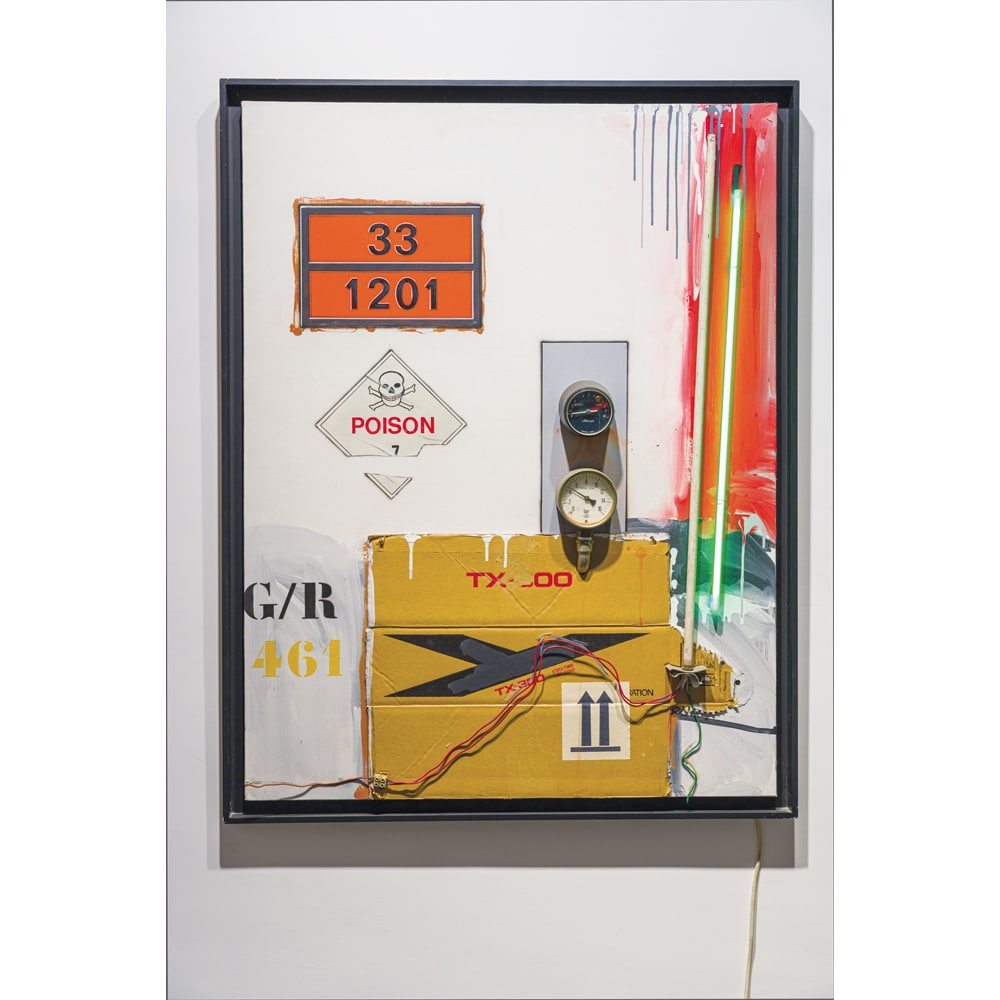
2001
1924, Osjek, Croatia – 2004, Paris
Paintings and drawings
Immutably faithful to the rigour of the constraints he has imposed on himself: the exclusive use of black and white, the choice of a single figure, but with infinite variations, derived from the meander and the absence of any trace of gesture, Julije Knifer has put an end to the obsolete questions of renewal and creation.
Through this quest for the absurd and the paradoxical, for almost forty years he has been putting forward, in the subtle rhythms of his refined meanders, a belief in art based on the most tenuous affirmation, that of his own freedom.
Catherine Macchi de Vilhena, Art Press 247, June 1999

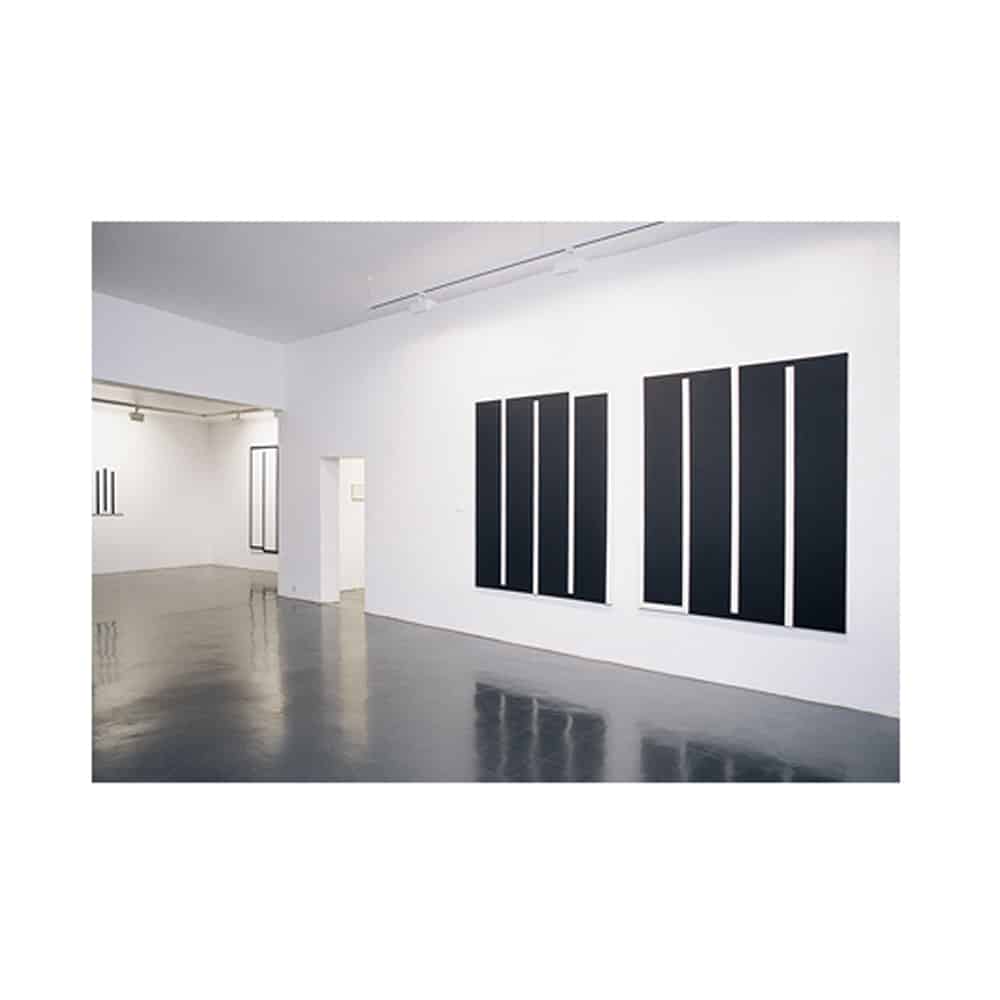
1923, Kansas City, USA – 2012, New York
Compass points
Matter pours onto the canvas in the excess and incandescence of colour, through a gesture that guides it generously, while safeguarding the authenticity of the thought. Nothing is said that does not correspond to a natural attitude, simply linked to the surrounding world and the creator’s invincible belief.
Jean-Louis Prat, March 1999, Saint-Paul

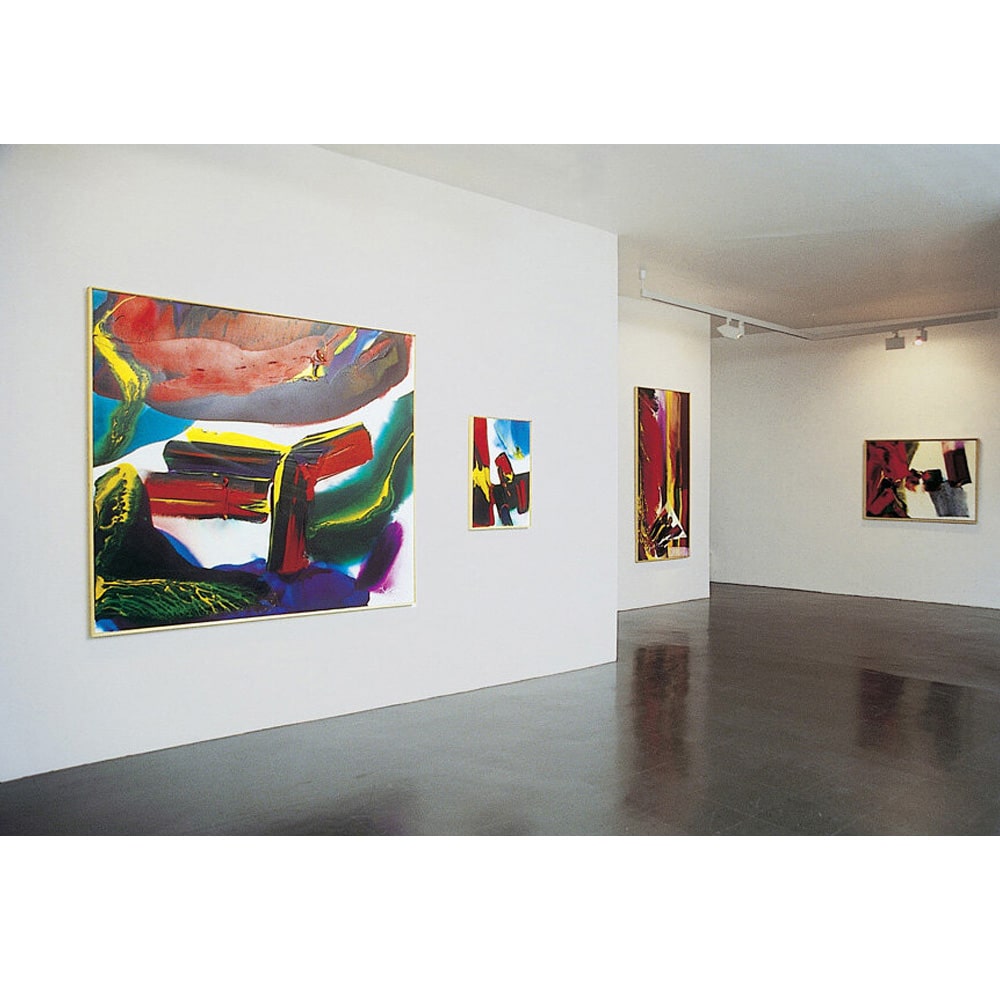
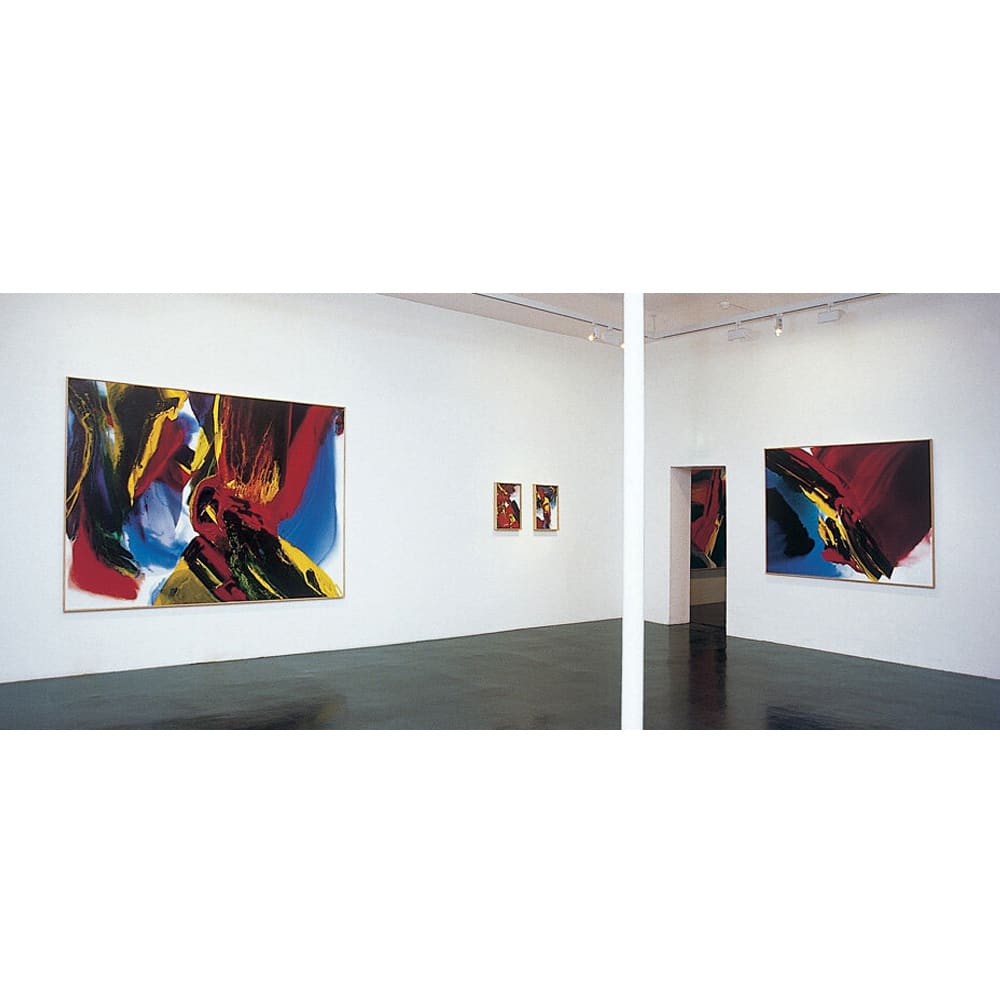
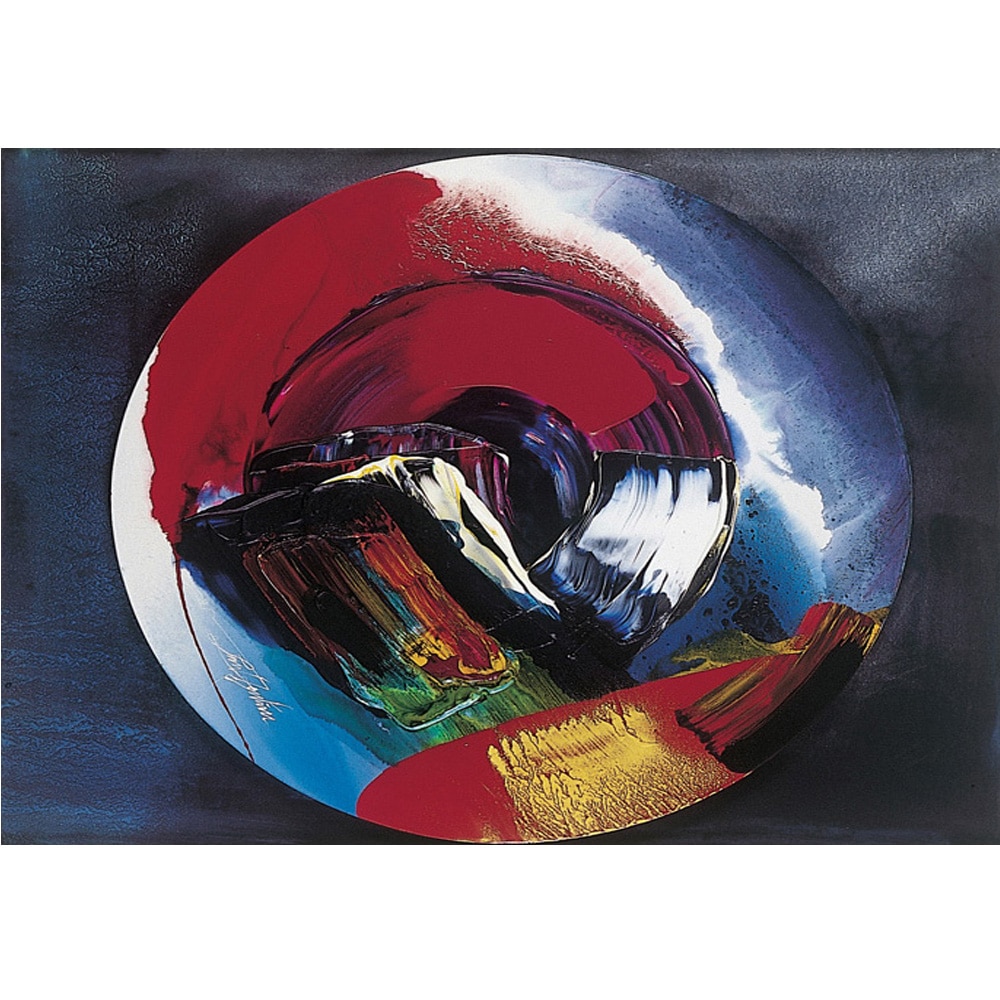
2002
1952, Locarno, Switzerland –
Lives and works in Paris.
Felice Varini’s work plays with the notions of visibility and invisibility, homogeneity and diffraction of painted forms, composition and decomposition, appearance and disappearance, real time and anachronism. Nothing is set in one characteristic but each one plays with its opposite, the borders between one and the other are blurred, ambivalent and, like a musical score, many variations are possible.
The whole is based on the interaction of a real space, experienced by the observer, and a purely geometric and objective formal construction, or a subjective photographic implication, since it is the immobilised result of an instant.
Extract from the press release of the exhibition

1917, Zurich, Switzerland – 2016, Zurich
Recent works
Beyond a futile desire to curb the melancholy of a paradise forever lost and pessimism when confronted by a modern world exacerbating the Earth’s worsening state every day, Honegger prefers to engage in an aesthetic that accepts artifice as an artistic hope.
His new creations – hollow forms – are industrially painted in different colours in order to remove all romanticism from the artist’s hand. Hanging on the wall, they let the light pass through and diffuse it, metamorphosed in this hollow which suddenly becomes the support of the concrete interpretation of the coloured light. Thus, the same shape painted with different colours “mechanically” induces a change of shape.
Extract from the press release of the exhibition
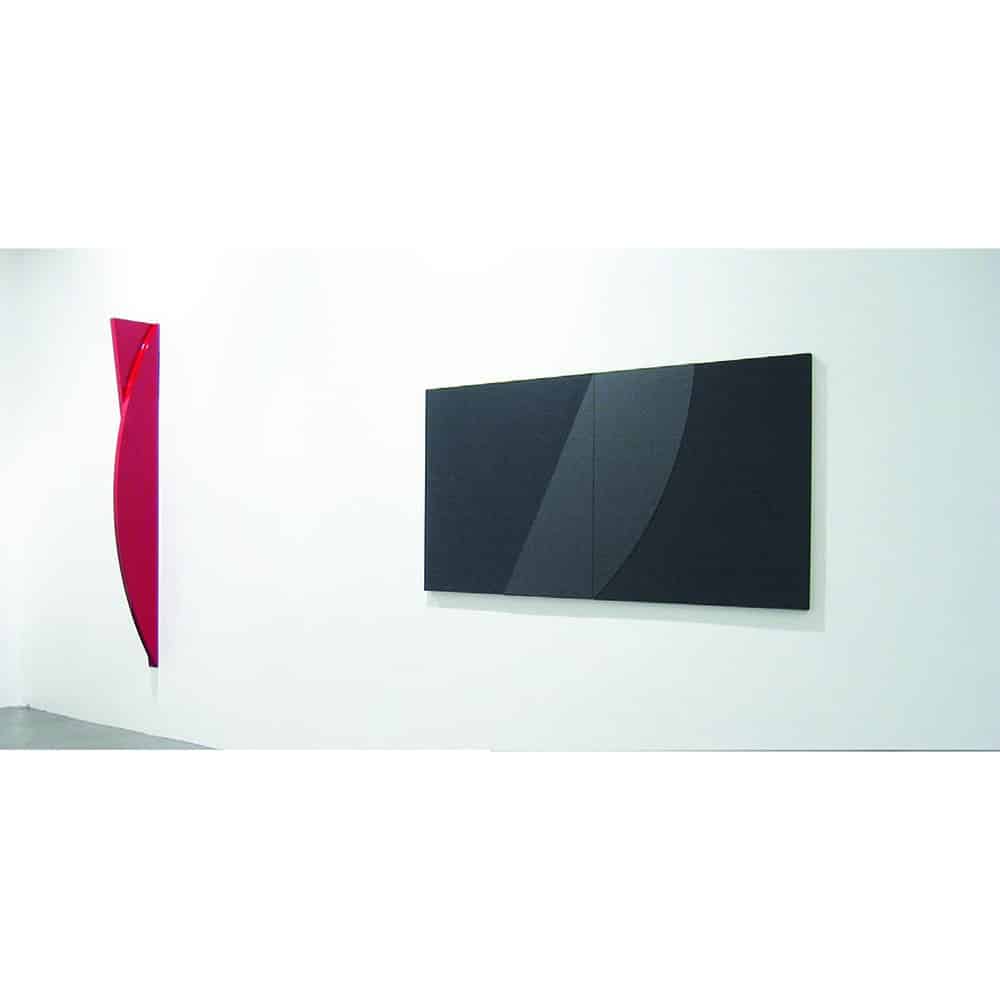
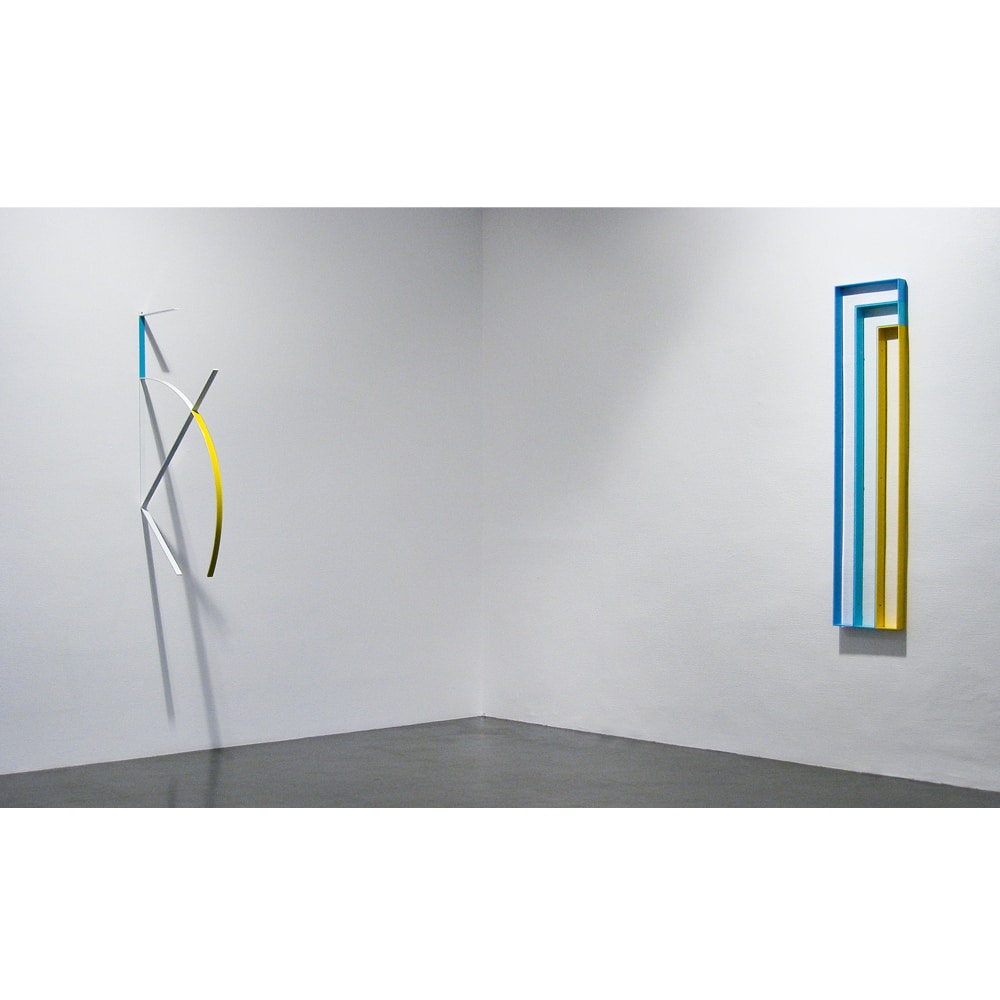
2003
Francis Limérat, 1946, Alger –
Lives and works in Paris and in Entre-deux-Mers, France.
Tanguy Tolila, 1948, Cambrai, France –
Lives and works in Angers, France.
Reliefs/Paintings
Francis Limérat composes structures by means of thin wooden rods linked with invisible glue, which create his “Figures du vide” (“Figures of the void”). Any surplus is subtracted, generating at random the appearance of structured drawings in space, like a composition based on a variation of rhythm between transition, suspension and silence.
Tanguy Tolila superimposes multiple layers of glazes that accentuate the light and diffuse the transparency of white while letting a few touches of colour filter through.
Extract from the press release of the exhibition
Tanguy Tolila’s pictorial creation is not additive, he proceeds by subtraction, the elements disappear little by little, to let only the essential show through.
Daniel Chabrissoux
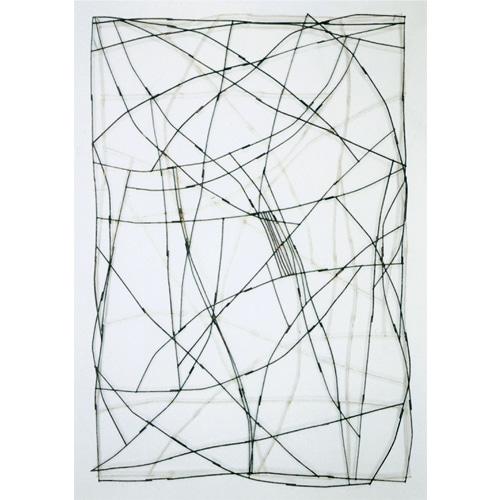

1956, Chalon-sur-Saône, France –
Lives and works in Paris.
Ouvertures, Découpes, Passages
Illuminate, project, situate, orientate, look, frame, focus, encounter, travel. How do we exhibit this interlacing of successive actions that follow one another often very quickly and are sometimes even simultaneous? How can we bring the visitor’s gaze, journey and understanding back to what is basically physical in what surrounds them (starting with light, matter, space and time), to what they are given to see immediately through the intermediary of these phenomena, factors or physical parameters, and, at the same time, to what is more specifically human – among other things, a reflection on what precisely this gaze, this journey and this understanding are?
Michel Verjux, excerpt from “Un rayon de lumière, un fragment de monde, un temps de réflexion”, November 2002

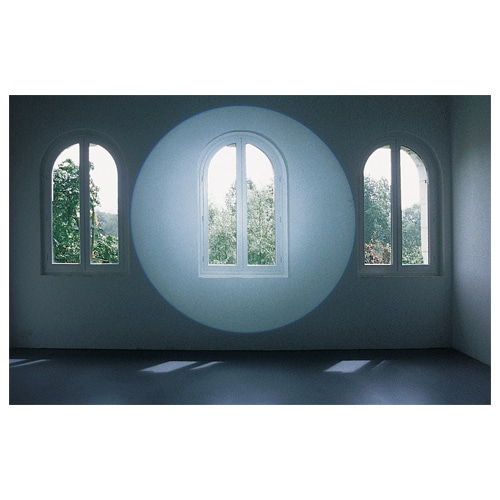
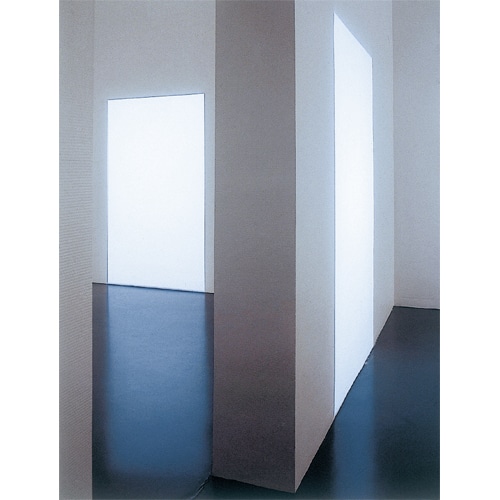
2004
1960, Vienna –
Lives and works in Montreuil, France.
Devoid of all ornament, Susanna Fritscher’s work is striking in its absence, its silence and pierces the shadow’s enigma. It is not a question of knowing whether what is depicted ever existed or of bringing painting back into the realm of self-exoticism or the sublime, but of pursuing the implementation of other possible ends. Anonymous and ordinary, the places transformed in this way float and thus open up to unsuspected landscapes.
It may be that a whiteness defined in this way has no real existence. It may be that it is only a deceptive and ephemeral play of light and shadow. It is then a matter of turning around, over and over, to see them again. Then everything slips away, doubt sets in… and time stops.
Galerie Blancpain Stepczynski, Geneva
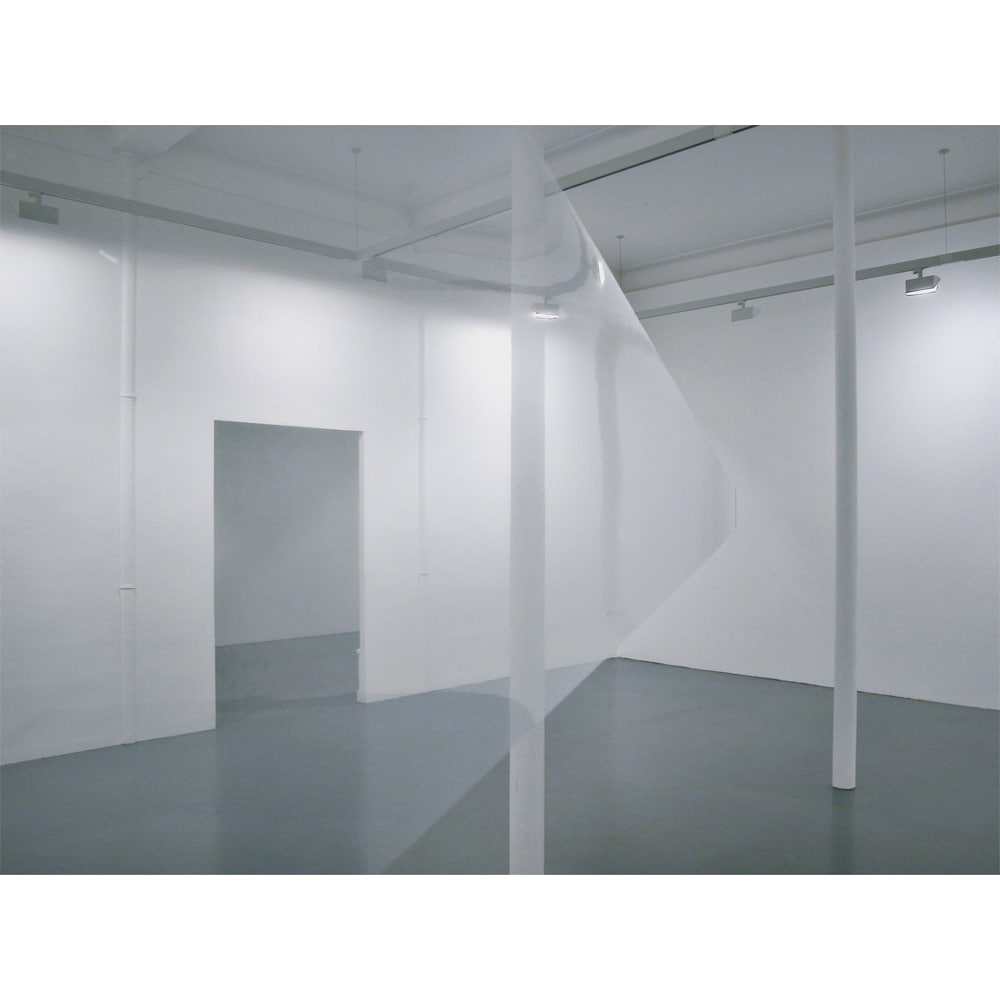
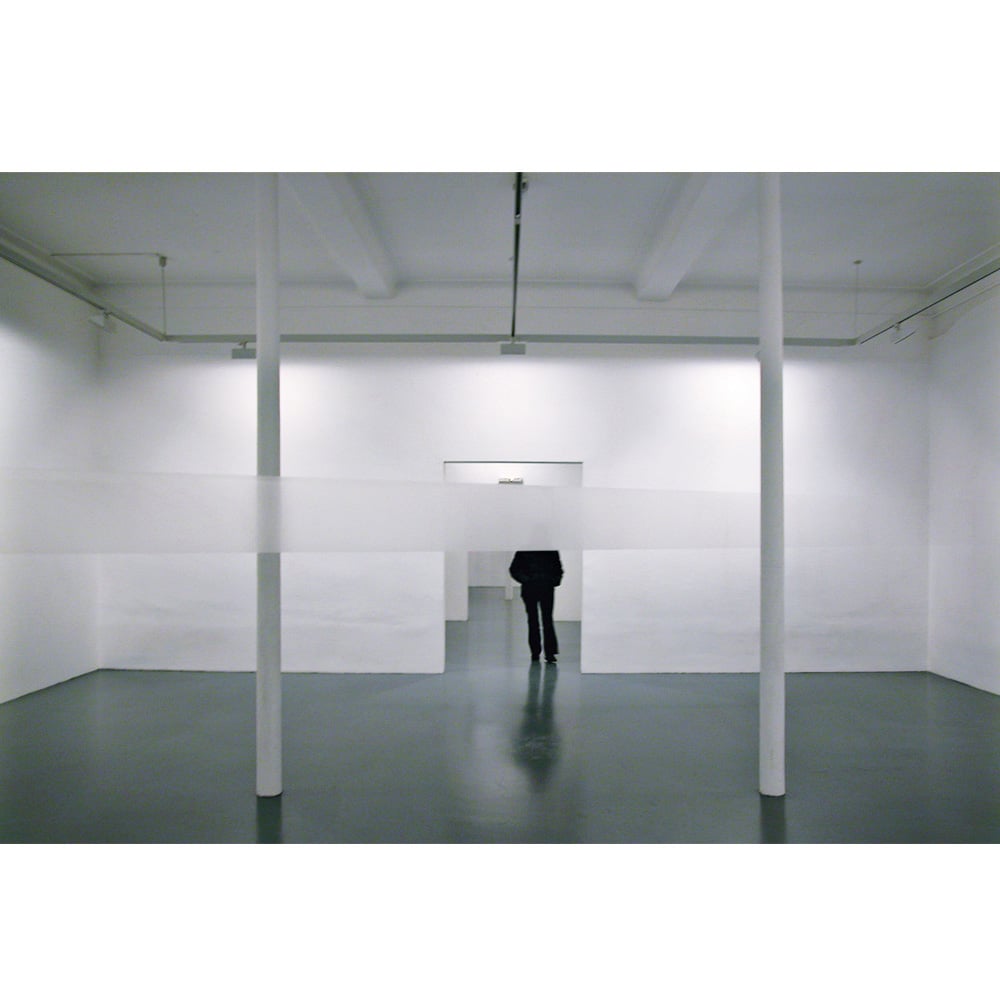

1952, Marseille, France –
Lives and works in Paris.
“Of course, I’m probably not totally emancipated, since I am keen on the autonomy of painting, without completely abandoning representation. This is why I define myself as a non-figurative painter rather than an abstract painter.” – Gérard Traquandi.
Traquandi’s painting is in the twilight zone, in this in-between where the painter performs a balancing act that must avoid the pitfall of a painting that is too physical and sensitive, and that of its opposite, a painting that is too bloodless, too conceptual. Gérard Traquandi paints this research of the point of equilibrium.
Elisabeth Védrenne, “Le voyage immobile de Gérard Traquandi”, Connaissance des arts
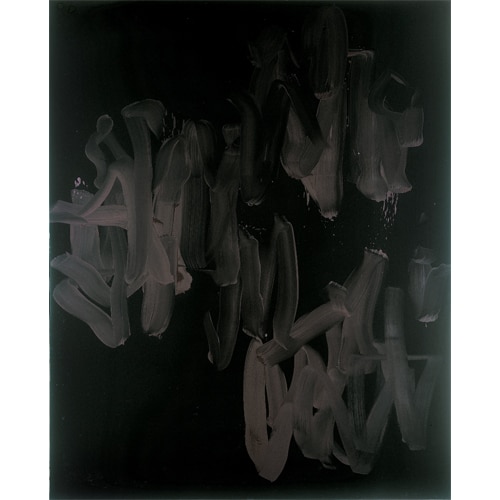
2005
1948, Heemstede, Netherlands –
Lives and works in Haarlem, The Netherlands, Reykjavik and Paris.
The retraction of the coloured plane in relation to the plane of the medium, the manipulation of the quadrilateral, this slight deviation of the form in the format accentuated by the lower margin, which is slightly larger than the other three, make it possible to give priority to the objective pictorial presence by disturbing our automatisms, our perceptual habits. But it is also a way of breaking with a certain illusionism inherited from the modernist tradition: that of the supposed extension of painting outside the frame.
Hubert Besacier, excerpt from “Réflexions sur l’art” (Pratiques no. 15, Spring 2004)


1943, Nages, France –
Lives and works in Paris.
Sensible exemplaire
That colour and line are in their intensity and purity a visual thought, a space alternately light and suspended, or radiating with a dark force: this is the zone where Monique Frydman has established her work. Unlike ‘anti-contemporary art’, where the place of simulacra and installations serves as a medium for thought, here it is nothing other than the renewed, reaffirmed experience of painting and of the painting. But what to paint, again? Or rather how to paint, to make what I would call here the colour-thought happen.
Christine Buci-Glucksmann
Monique Frydman is today one of our major colourists. The sumptuousness of the productions in progress visible in her studio says it all.
It also shows to what extent the artist inhabits her painting, lives inside her painting, in the circulation of her paintings which are each time new while also intersecting with an older moment.
Yves Michaud, “Monique Frydman”, Les Authentiques, Flammarion
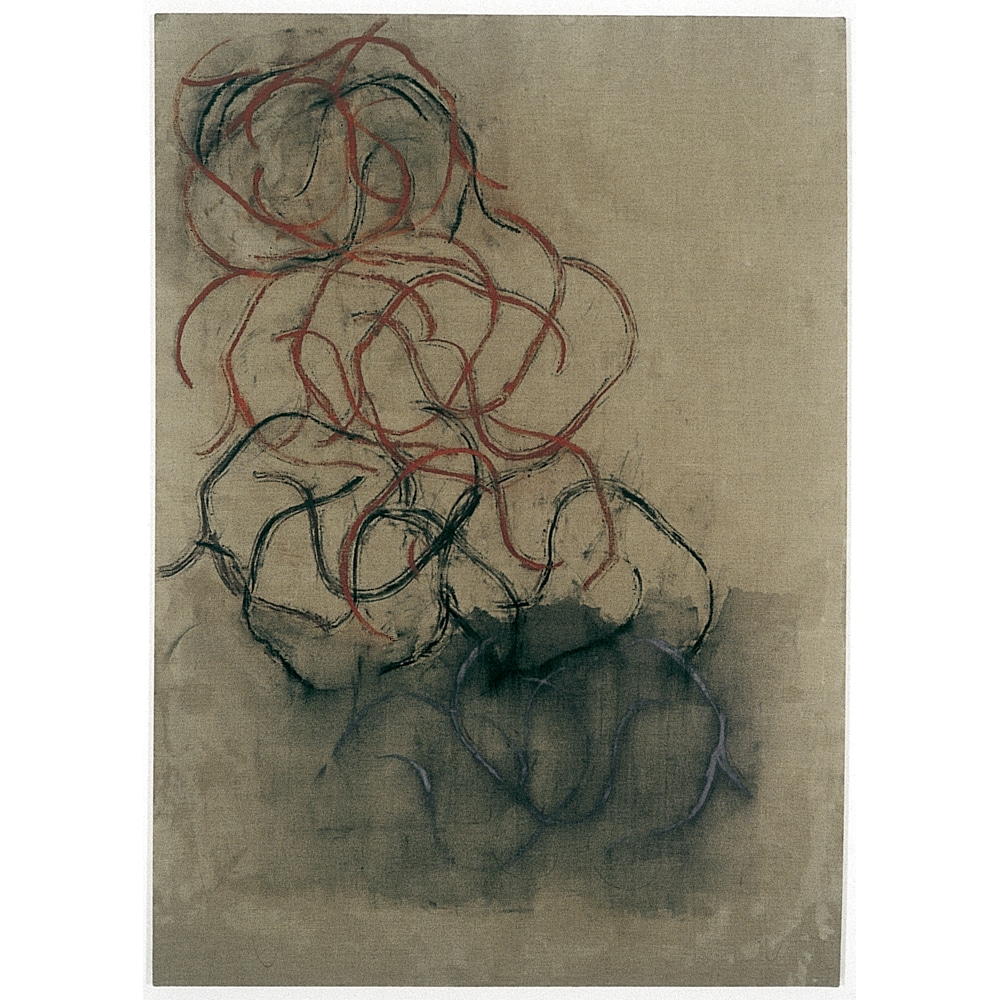
2006
1971, Saint-Nazaire, France –
Lives and works in Nantes, France.
Winner of the Bouvet Ladubay award of Contemporary creation
The project carried out within the exhibition of the Art Center is the encounter of different research. The work, resolutely oriented towards drawing, is deployed in the space on its flat areas (walls, windows) playing in a simple way with the site, either through the hanging or installation (in situ) layout.
Éric Gouret, April 2006
Éric Gouret, avril 2006
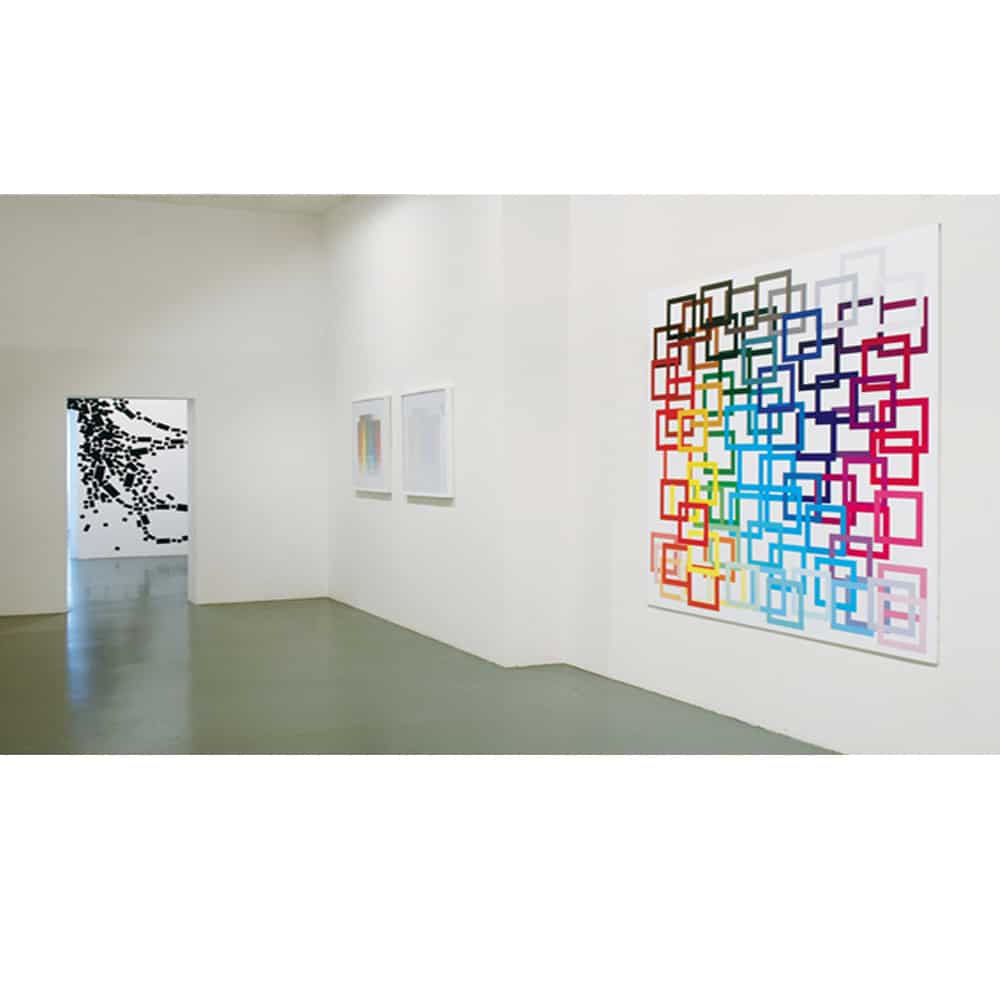
1931, Wigan, Great Britain – 2023, Lille, France
L’esprit des systèmes
Concrete art is often associated with a so-called lifelessness of systematic creation. Norman Dilworth’s oeuvre demonstrates that ultimately, invention, imagination and artistic power can overcome the system used. Looking at his work, images emerge that one associates with natural forms of growth; this aspect shows that, in Dilworth’s oeuvre, systematic principles on the one hand and suggestions of dynamism on the other are in no way contradictory but complementary.
Cees de Boer, 2001
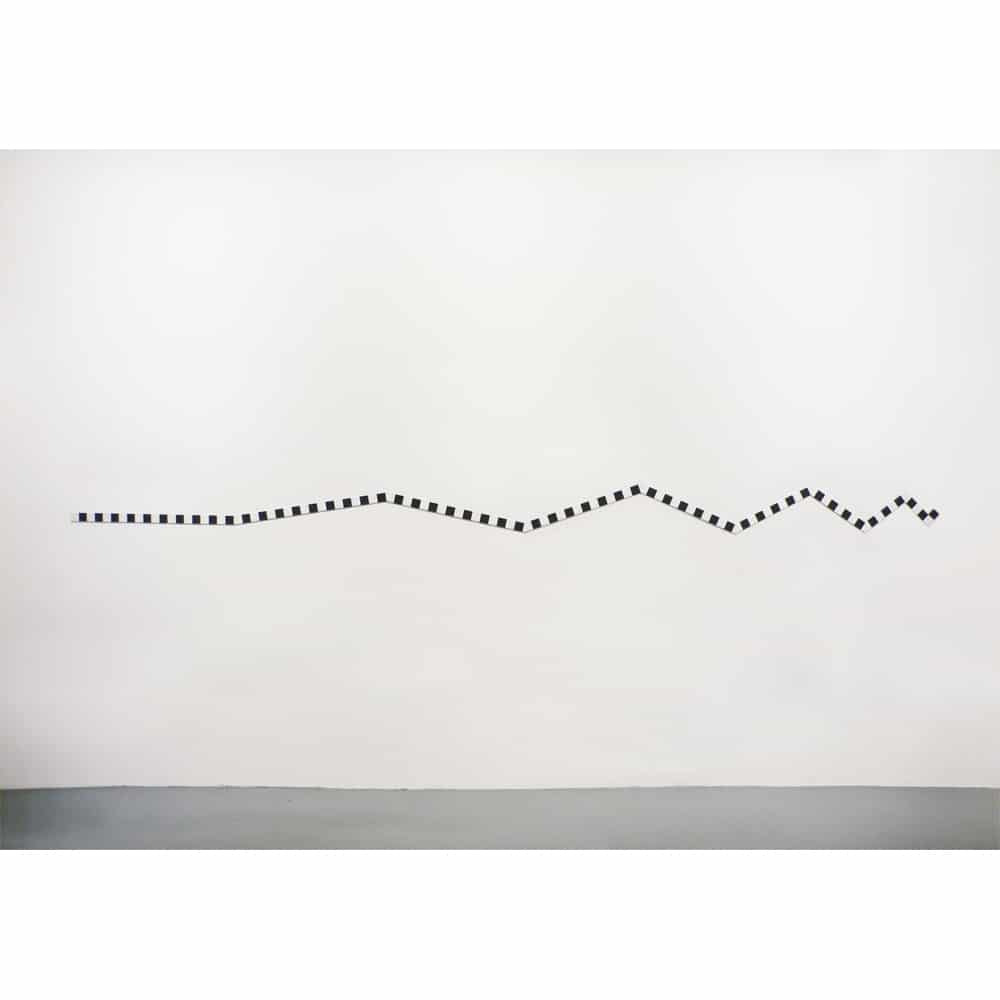
2007
Bernard Aubertin, Nicolas Chardon, Jean-François Dubreuil, Sam Francis, Monique Frydman, Gottfried Honegger, Paul Jenkins, Julije Knifer, Tobias Lehner, Benoit Lemercier, Jean-Luc Moerman, Miquel Mont, Aurélie Nemours, Niele Toroni, Claude Viallat, Kees Visser, Jens Wolf
Is it possible to conceive of a colour that is not inscribed in a form? And conversely, can we imagine a colourless form?
Colour shapes, forms and distorts space. This means that colour is as structuring as form. In the 20th century, colour freed itself from the figure; in the 21st century, colour can free itself from the reductive divisions between form and colour, lyricism and geometrism, gestural abstraction and concrete abstraction, sensualism and intellectualism, chance or necessity of the pictorial gesture. A new path has been opened: that of a colour that fully assumes its autonomy. If colour has been able to free itself from the constraint of form, it is because it is itself a form.
The Forms of Colour exhibition is guided by a purely retinal choice. The works exhibited testify, beyond the variety of styles proposed, to the multiform permanence of colour.
Olivia Gazalé, philosopher, introduction to the exhibition catalogue, 2007

Sam Francis, on the left and Jean-François Dubreuil, on the right.
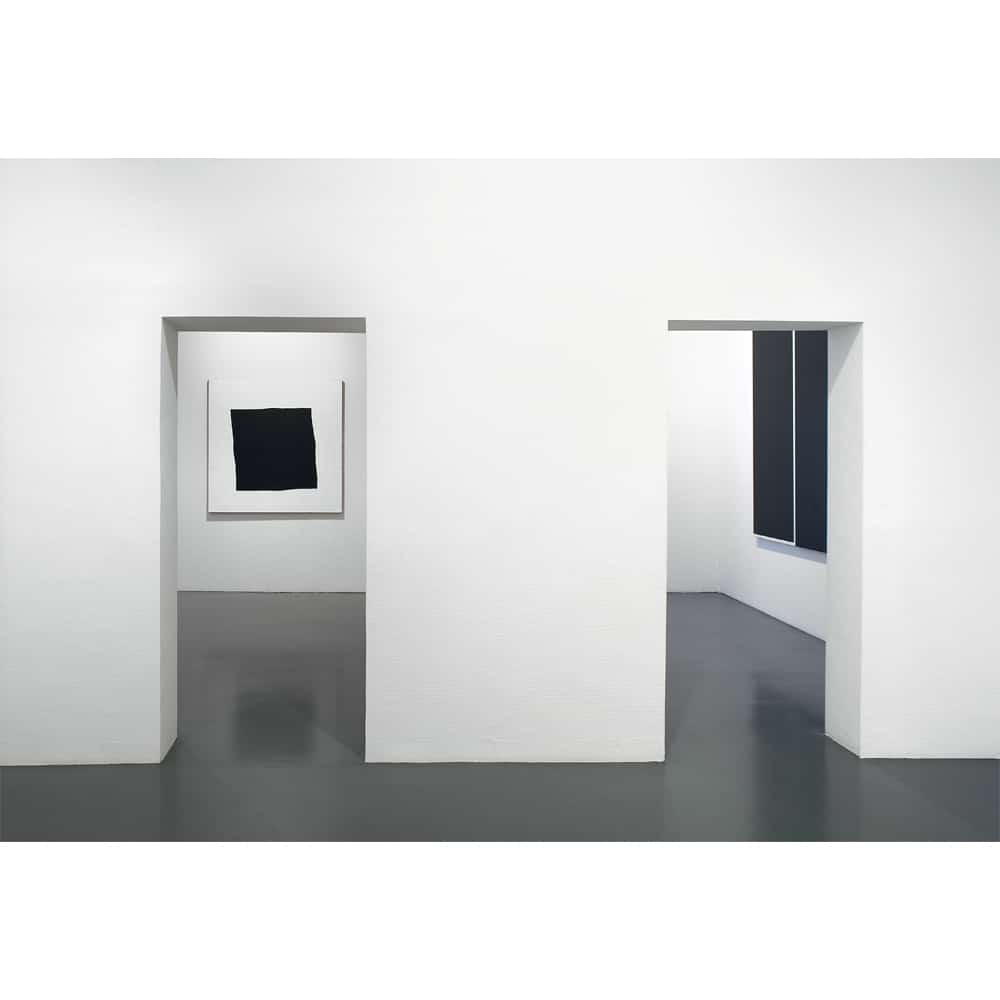
Nicolas Chardon, on the left and Julije Knifer, on the right.
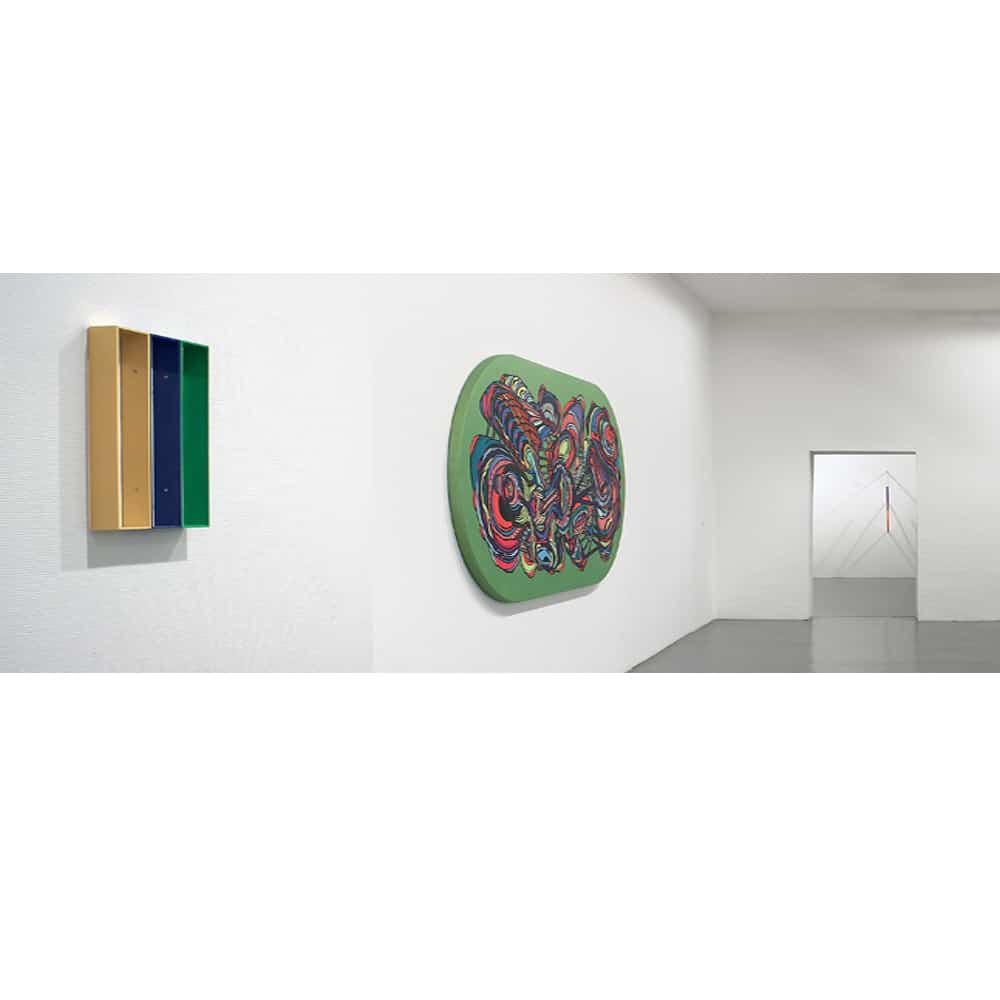
Gottfried Honegger, on the left and right, Jean-Luc Moerman, at the center.
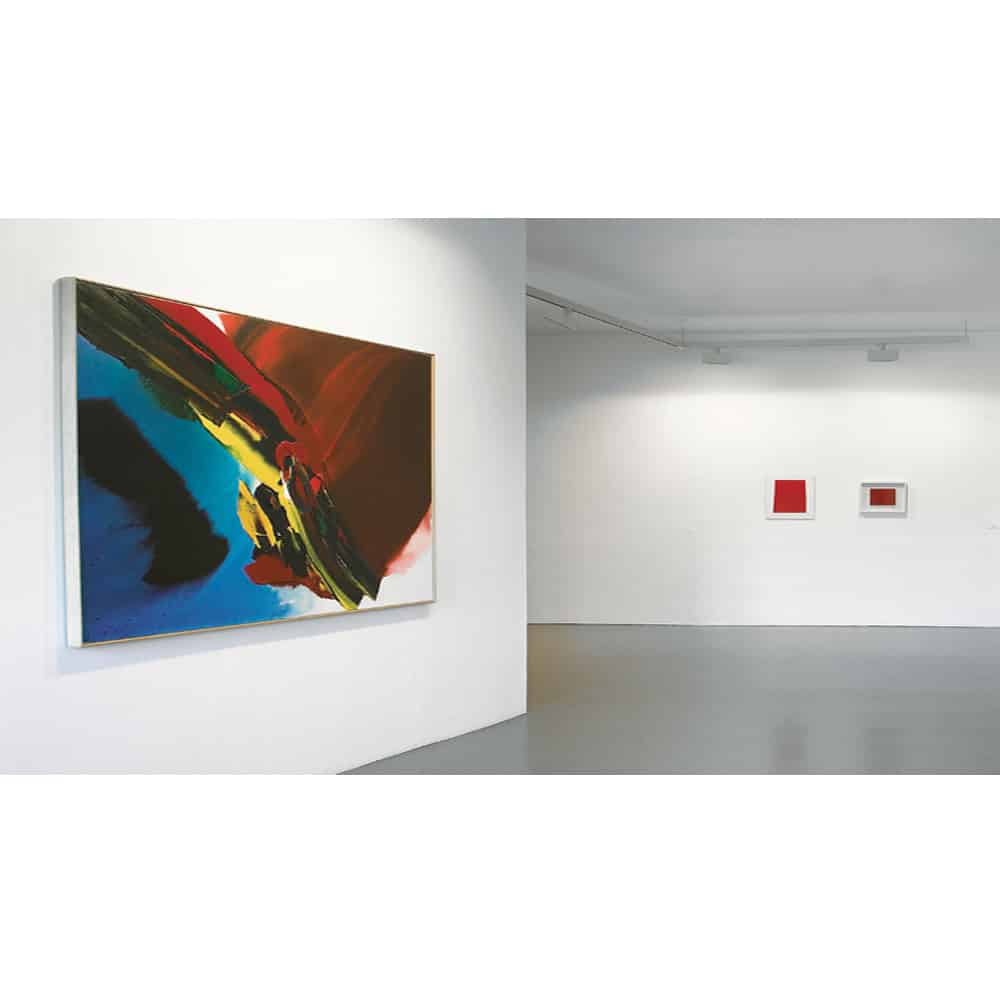
Paul Jenkins, on the left, Kees Visser, at the center, and Bernard Aubertin, on the right.
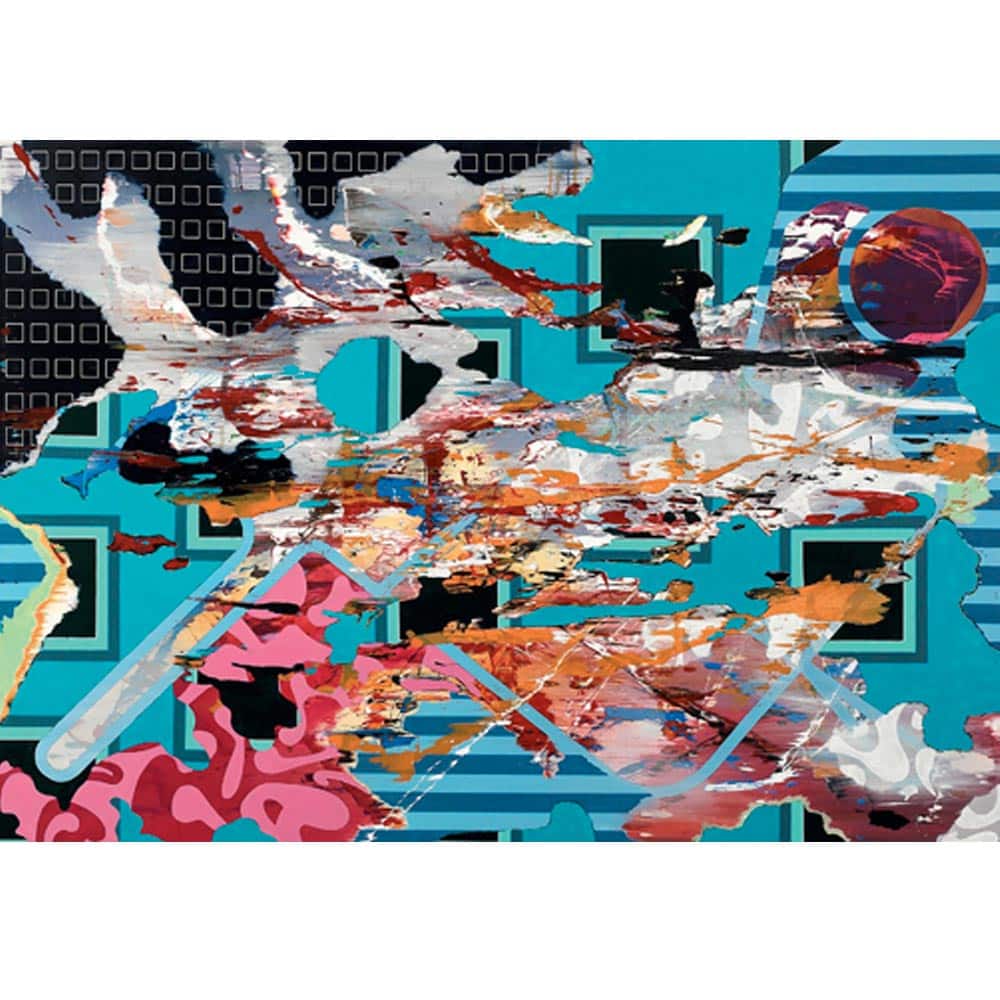
Tobias Lehner
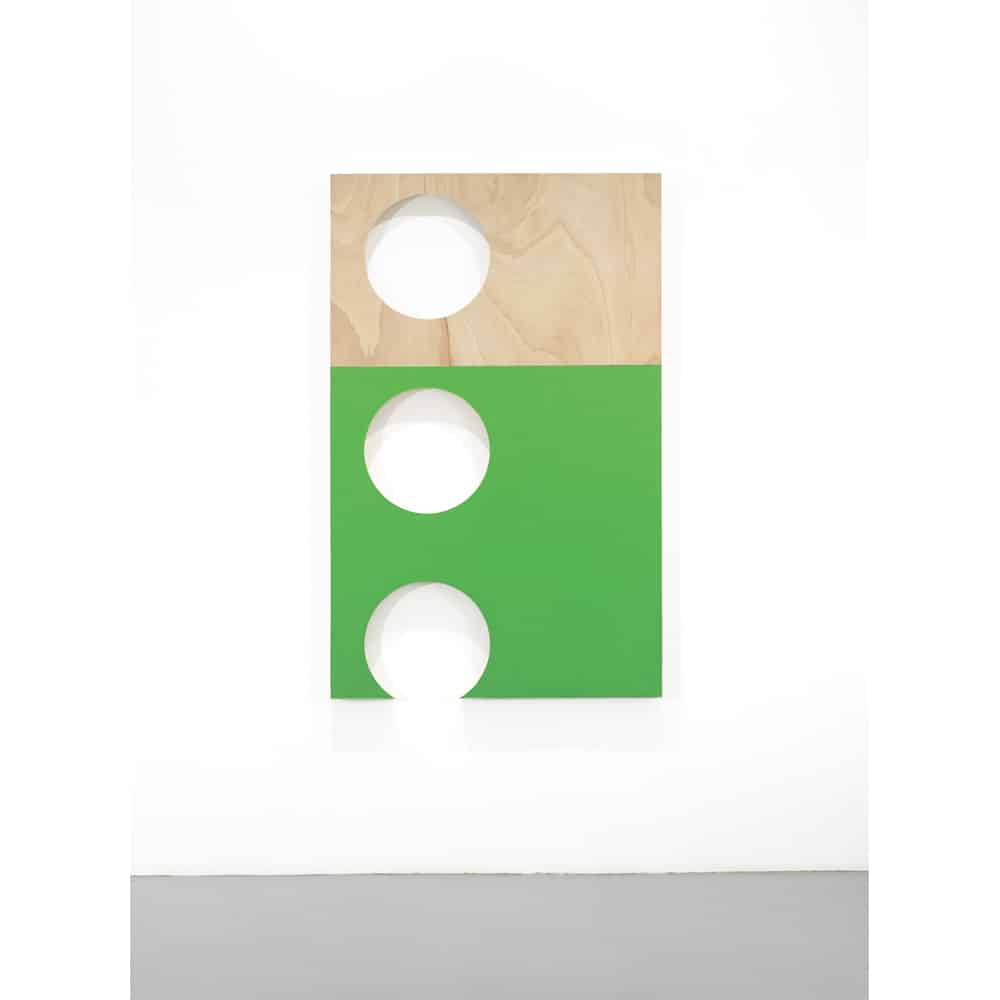
Miquel Mont
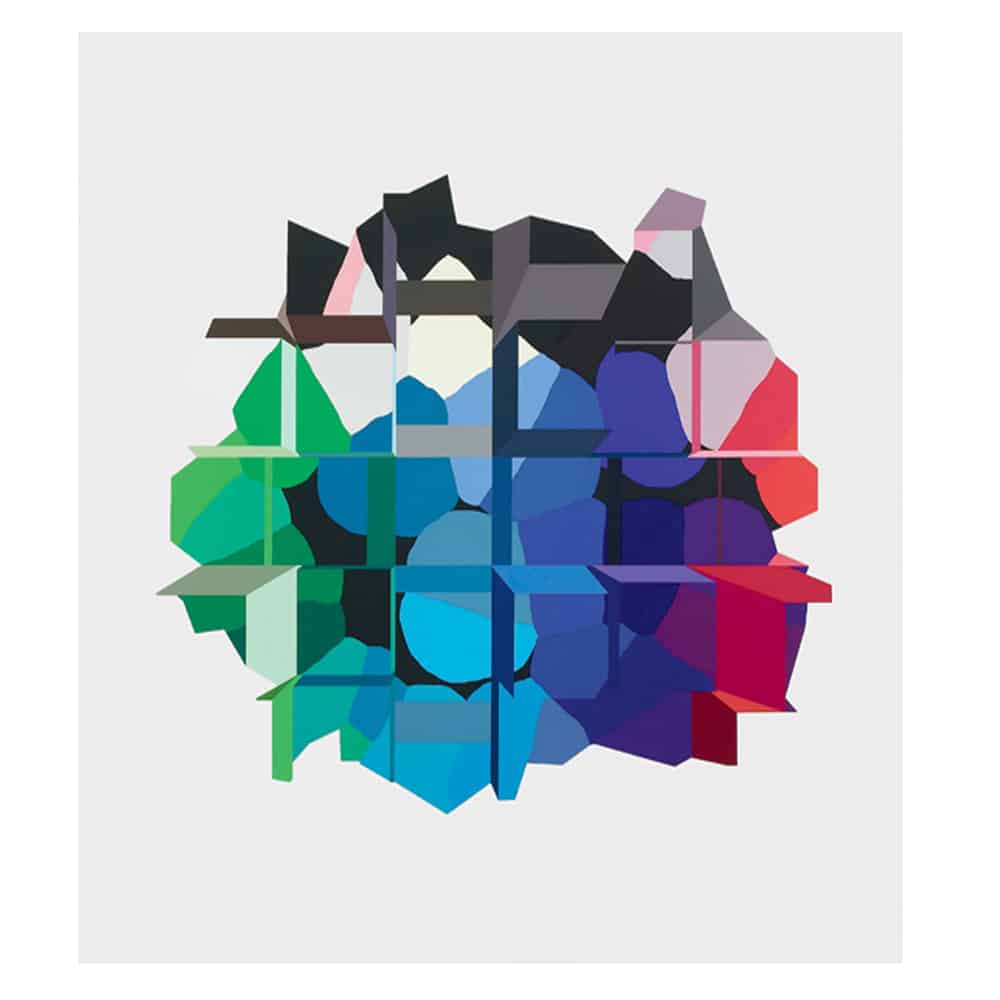
Benoit Lemercier
2008
1964, Marseille, France –
Lives and works in Paris.
Winner of the Bouvet Ladubay award for Contemporary creation.
Natalie Lamotte’s paintings marshal the gaze, appeal to it, animate it and make it vigilant. It is therefore not a question of constructing images that summon reality, but rather of showing that the reality of the image is the access to reality itself. For this, all figuration and even the desire for transcendence through abstraction cannot intervene. To do so would be to reduce painting to vision. Natalie Lamotte does not make the image or the sign disappear, but gives equivalents and musters them towards the gaze and the gaze towards reality.
Damien Sausset

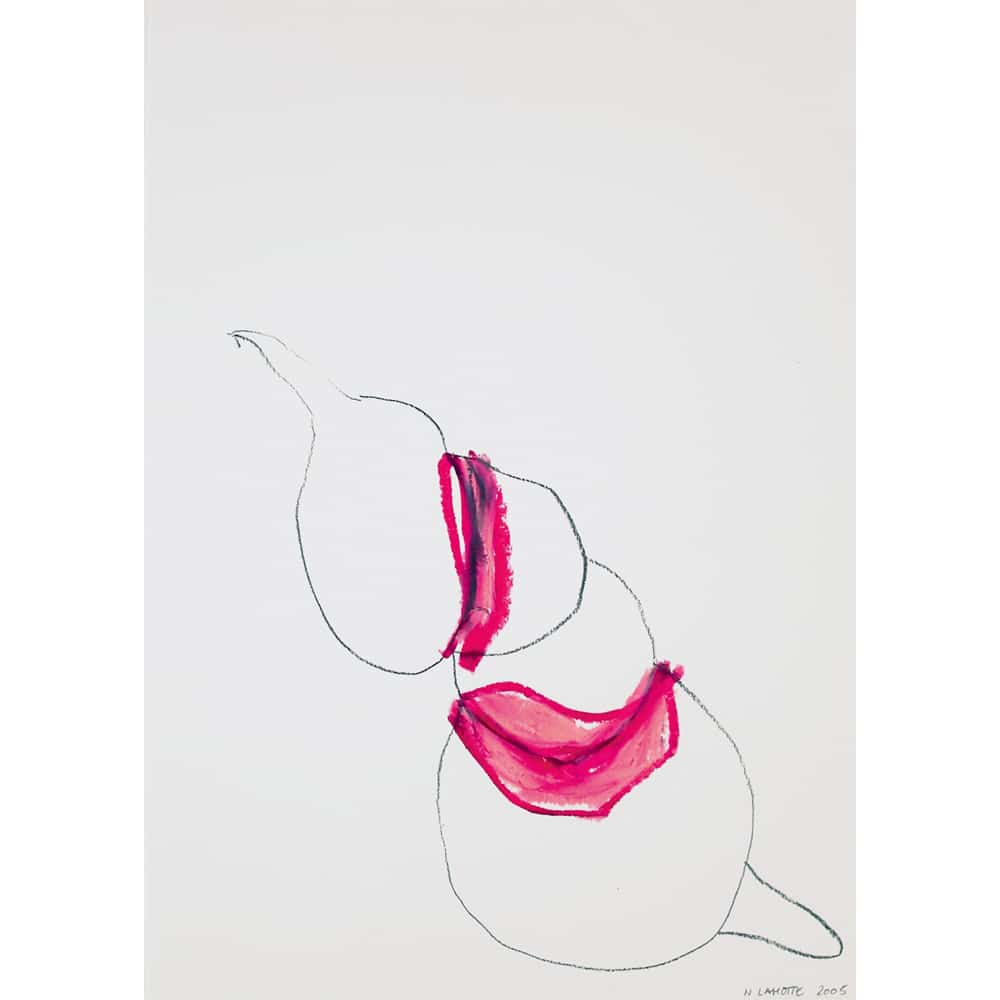

1966, Kanagawa, Japan –
Lives and works in Paris and Vallières-les-Grandes, France.
Several of Aï Kitahara’s most recent works deal with borders. Borders, which are nothing more than a geographical and arbitrary reification of difference, establish a relationship of reciprocity at a distance between objects, things and beings. Thus, in the series of pieces entitled Quinze mètres carrés de frontières (Fifteen Square Metres of Borders), Aï Kitahara shows that although borders generally exist on paper, their volumetric translation in the horizontal plane reveals a rugged relief no less fertile in contrarieties, resistances and other obstacles than, for example, the European construction.
Jean Charles Agboton-Jumeau, excerpt from Aï Kitahara, entre appas et appâts
2009
1942, Paris –
Lives and works in Oulchy-le-Château, France.
Vue sur le Jardin d’Éden
& quelques pièces d’intérieur
In the gallery’s seven rooms, which are like so many plots of land assembled to accommodate the abundant series of Forests, Leaves, Jungles and Herbariums, Gérard Titus-Carmel invites us on a journey through his Garden of Eden.
In total, more than a hundred works from the last twenty years focusing on plant motifs are exhibited. Paintings, works on paper, drawings and prints worked with the brush, cut-outs, juxtapositions, superimpositions and collages take over the space. Monumental, medium and small format works that forcefully depict foliage, branches and forests in “a narrow gap between the concrete and abstract”.
More than an evocation of nature, this Garden of Eden is an invitation to an inner experience.
Extract from the press release of the exhibition

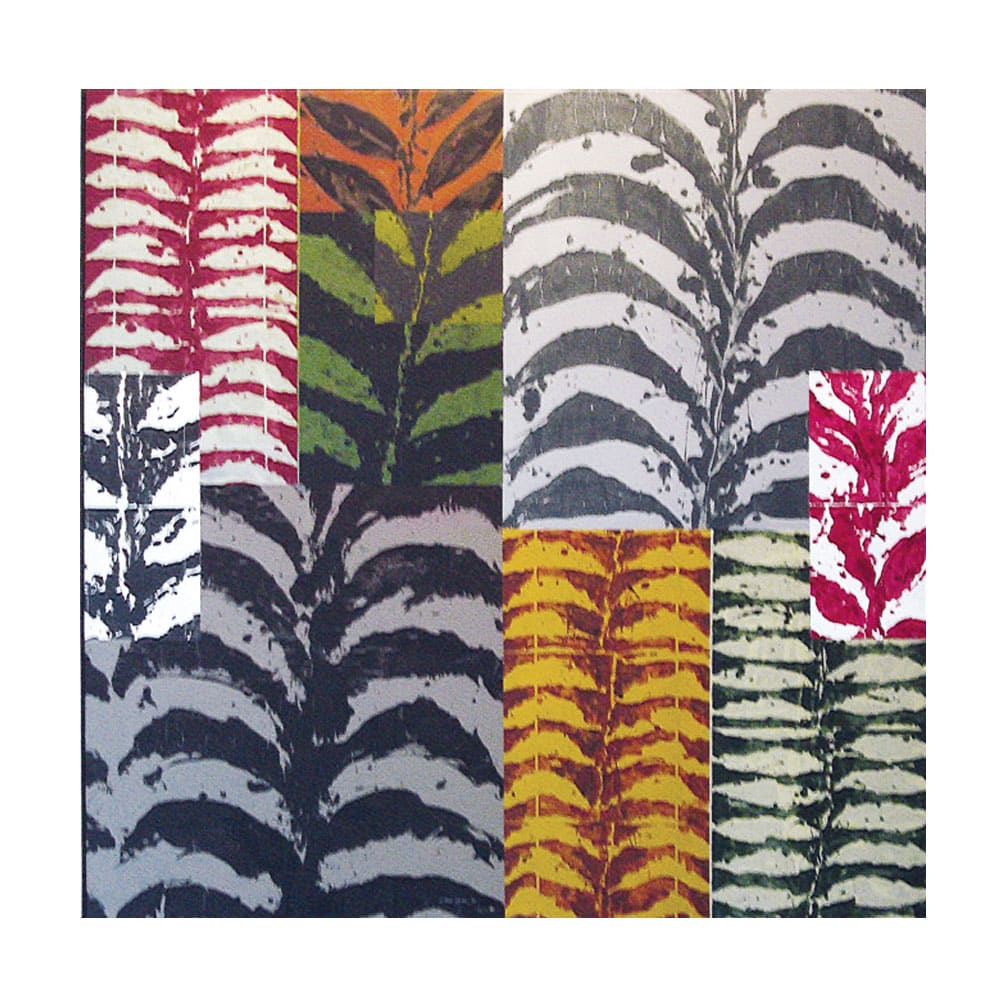

2011
Paul Jenkins, 1923, Kansas City, USA – 2012, New York
Gottfried Honegger, 1917, Zurich, Switzerland – 2016, Zurich
20 years anniversary of the Art Center
Bringing my two friends together in one exhibition is a dream I have had for a long time. Gottfried Honegger and Paul Jenkins had in common constancy and strength, sincerity and necessity. Their artistic practices, on the other hand, were opposites, like two poles that were not bound to meet in the sphere of abstract art. Gottfried proposed geometrical forms, bare and preconceived before they were produced. He had a very political and materialistic view of the world. Paul’s painting was gestural and abundant, leaving room for incident and chance in its creation. He took a poetic look at the universe and experienced his work as a true spiritual transcendence. The exhibition highlighted this antagonistic vision of the world.
2012
1955, Niort, France –
Lives and works in Paris.
La suite birmane
Richard Texier likes to temporarily invest in very diverse, strong, sometimes distant places.
Leaving, settling under a shelter, finding materials on the spot and trying to make an artistic response in a precarious situation: his nomadic conception of the studio has become over time an essential, foundational principle in his oeuvre.
Extract from the press release of the exhibition
Richard Texier’s oeuvre reveals an incessant need to go further, further forward, further elsewhere, more completely in pursuit of the great human dream of elusive coherence. All I know about this coherence is: this language resembles this man, and this man resembles his oeuvre; like the universe that concerns him, he is in a state of expansion. And in this permanent upheaval, each work is a blossoming.
Daniel Pennac
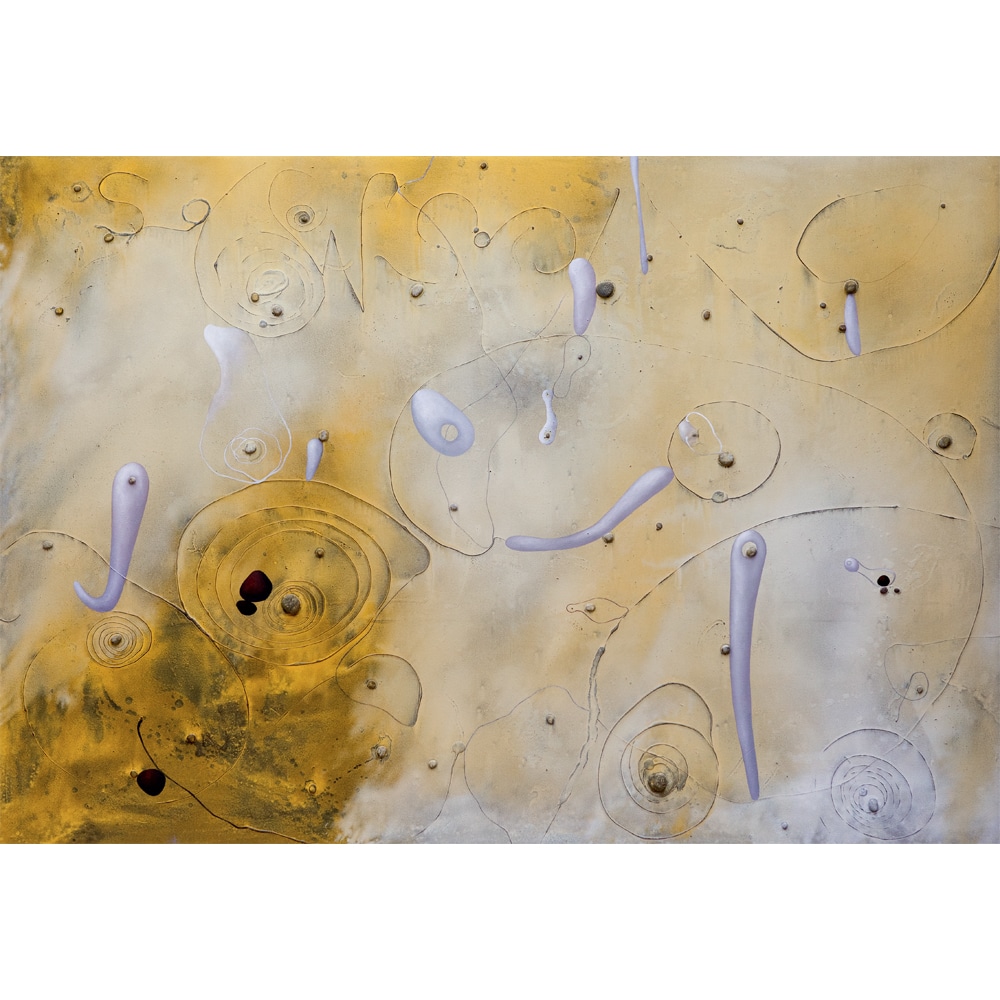
2013
1965, Angers, France –
Lives and works in Paris.
D’un infini à l’autre
Benoit Lemercier is the creator of mathematism, which highlights the predominance of mathematics in the functioning of the universe and uses science as a source of artistic creation.
His exhibition gives a poetic vision of the two geographical and temporal extremities of the universe: the Hypercubes propose a representation of the fourth spatial dimension in a set of geometrical, angular and black sculptures, which open perspectives and vanishing lines towards the infinite.
The Supercordes give shape to the infinitesimal undulations of the smallest constituent of matter through an interlacing of white ribbons.
Extract from the press release of the exhibition
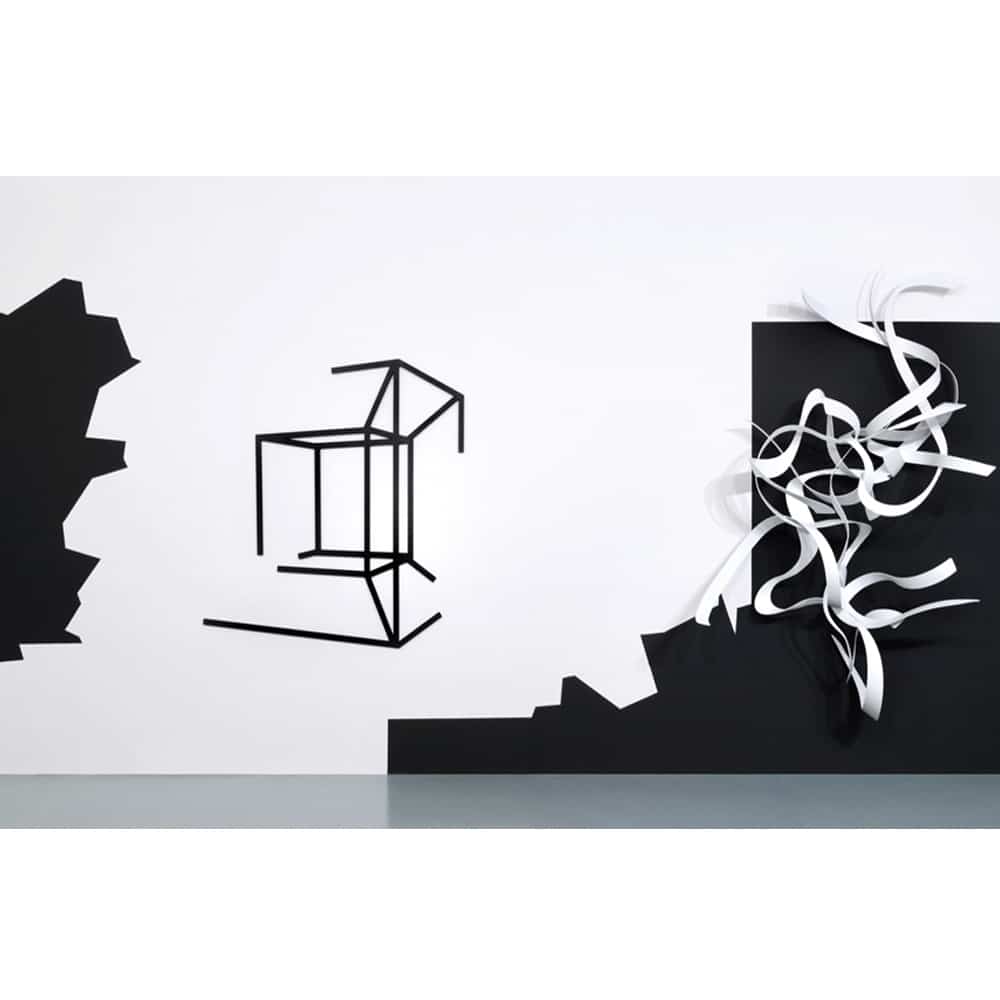

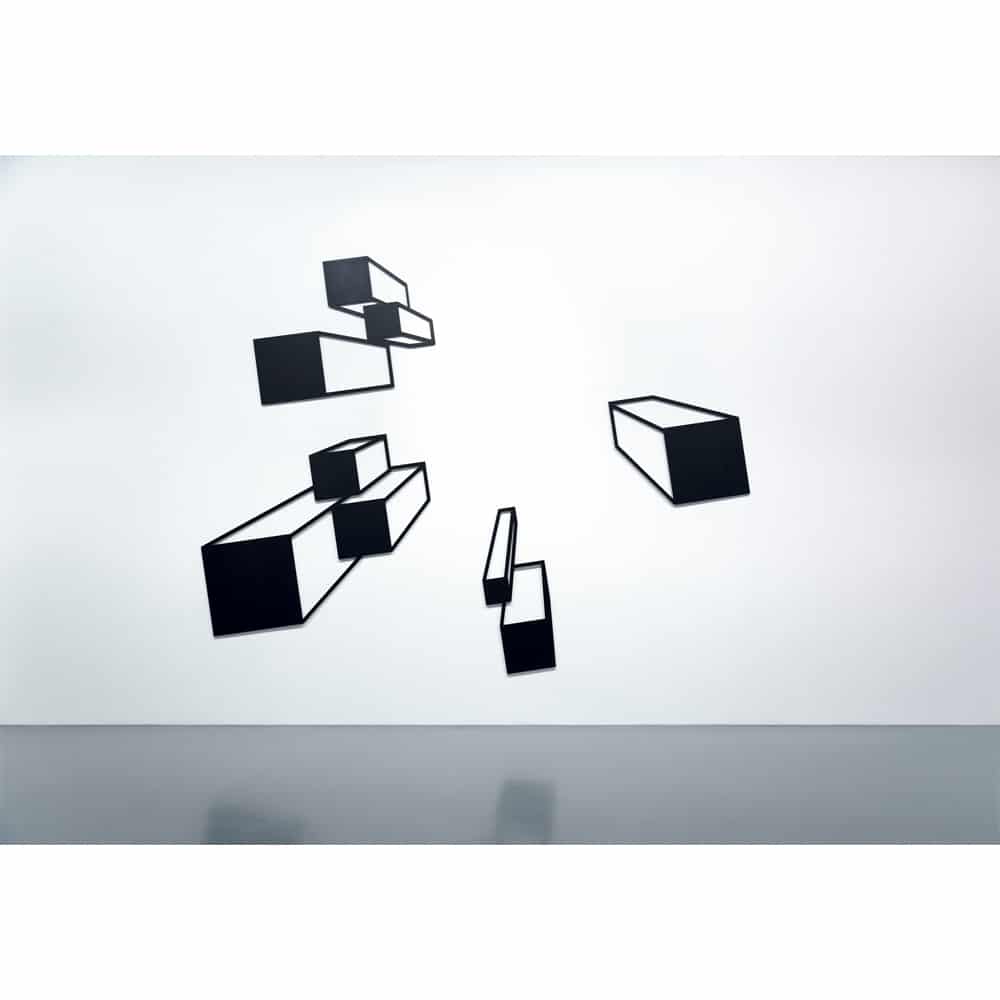
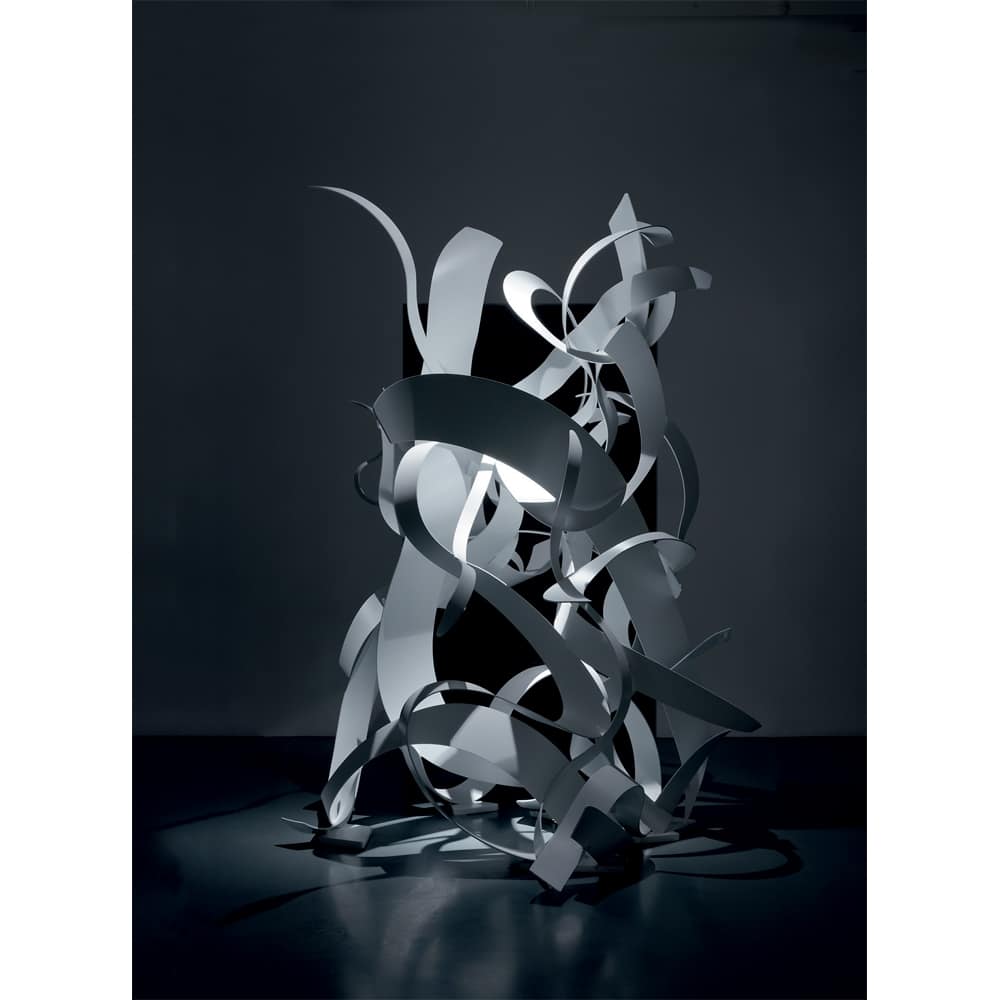
2016
Matthieu Boucherit, Niklaus Manuel Güdel, Julien Spianti, Pascal Vilcollet
By means of various artistic stratagems, Matthieu Boucherit endeavours to raise certain inconsistencies in the thought patterns conceived by the image and the powers that be.
Painting for Niklaus Manuel Güdel is an exercise in memory. His compositions strike a subtle balance between the drawn and the painted line, the evanescent whiteness of the characters and the vibrant colours, presence and absence, frivolity and gravity.
In Julien Spianti’s works, space-time boundaries no longer exist. It is his own memories, biblical stories or mythological figures that come to haunt a contemporary world.
Pascal Vilcollet’s pictorial universe is a teeming mixture, oscillating between realism, figuration and abstraction. Rather than representing, he opens a window on the world.
Extract from the press release of the exhibition
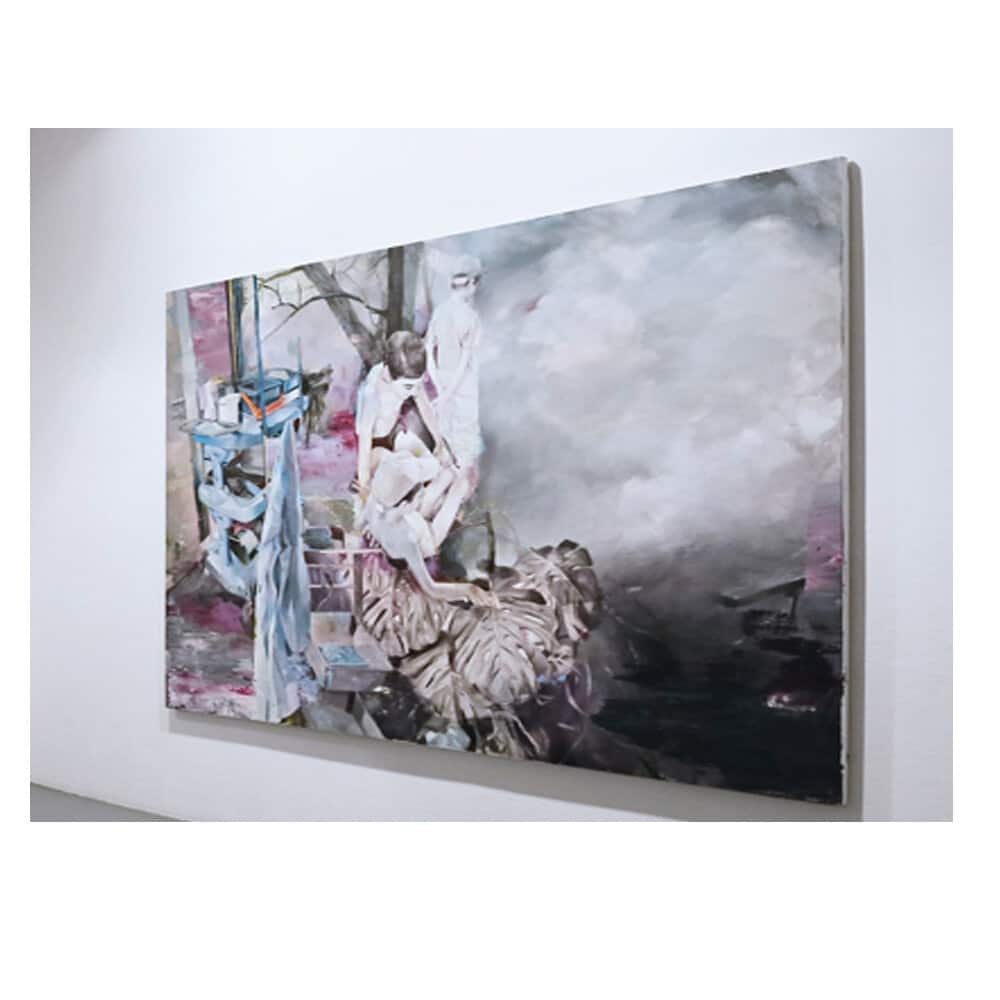
Pascal Vilcollet
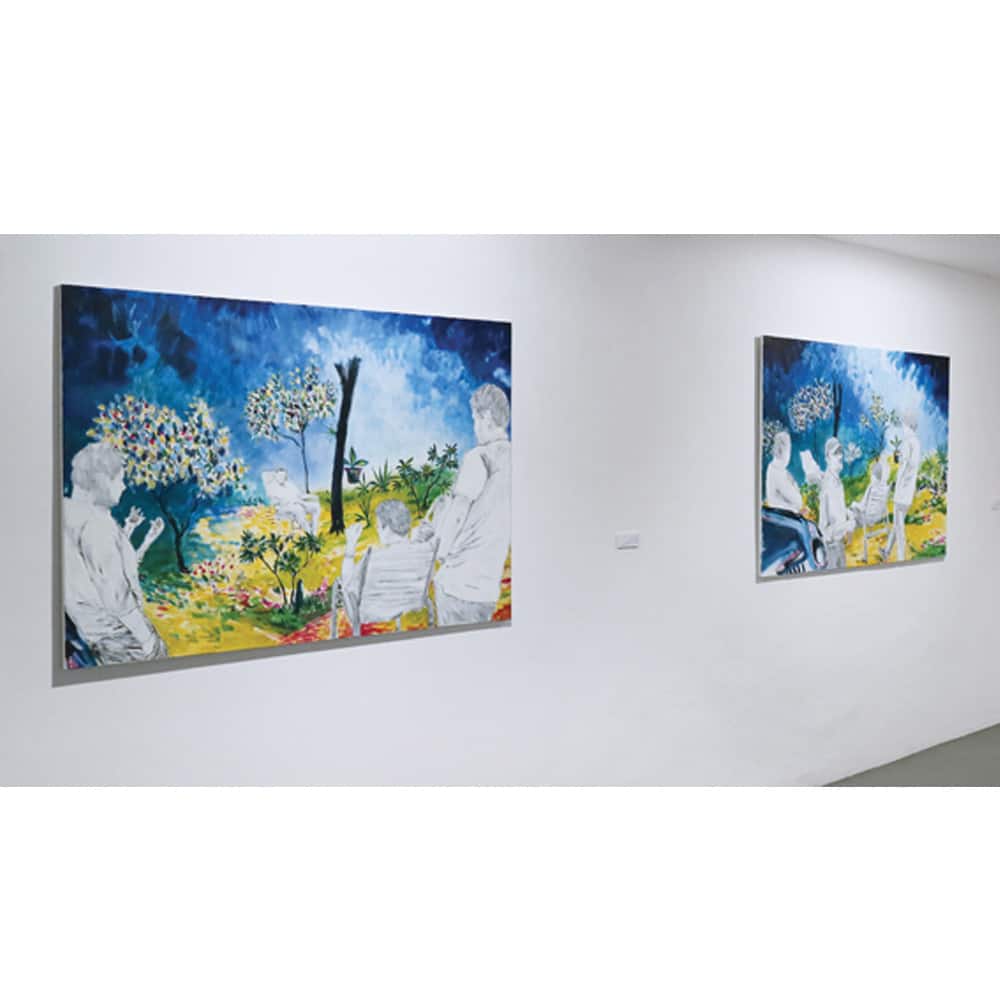
Niklaus Manuel Güdel
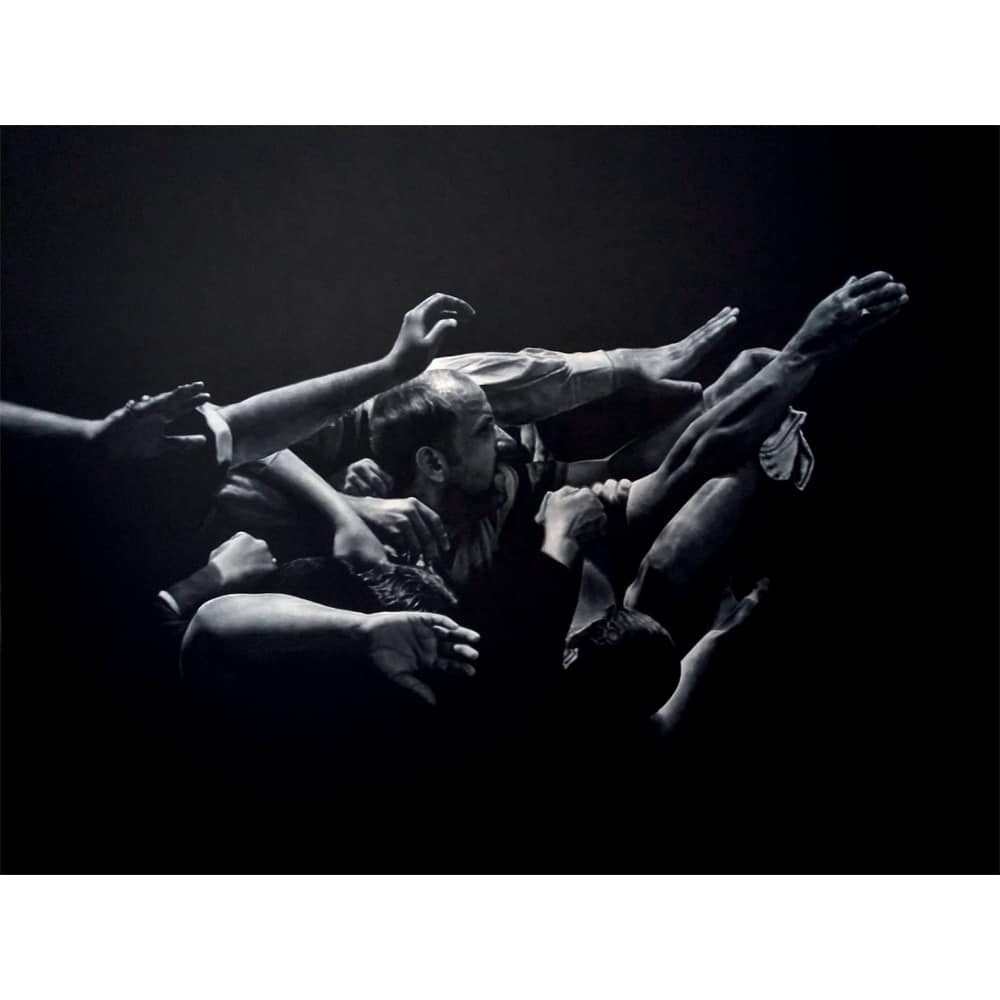
Matthieu Boucherit

Julien Spianti

Julien Spianti, à gauche, Matthieu Boucherit, au centre, et Pascal Vilcollet, à droite
2017
1939, Nîmes, France –
Lives and works in Paris.
Trajectoire – Œuvres de 1969 à 2017
We create objects of “knowledge”, which is to say viewers must recreate the artwork and as a result, have an intellectual approach that puts them on the same level as the painter. This springboard of thought is revolutionary.
As in a poem, I show a meaning that is not straightforward, didactic or simple to discover, but which allows this detachment of thought. Starting with sensitivity and a minimal education, the aim is to arrive at a greater knowledge of the world and of oneself, through art.
A few more words about colour. To put it simply that colour does not exist: there are only colours, almost infinitely many, given the mixtures, natural colours and today, artificial colours.
André-Pierre Arnal, interviewed by Jean-Pierre Huguet, exhibition catalogue, April 2017
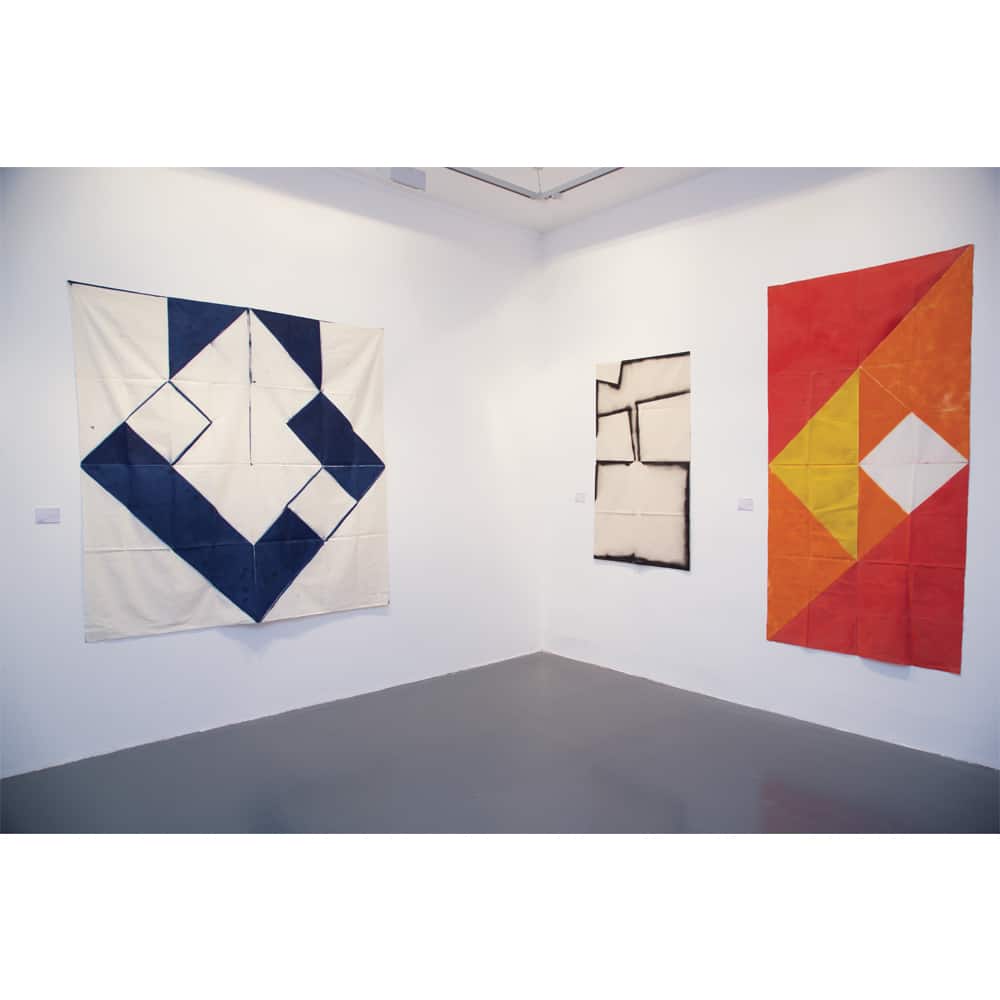

2018
1944, Kyoto, Japan –
Lives and works in Paris.
Sideral Blue
The first retrospective of the artist in France, the exhibition conceived by Yoyo Maeght presents 25 years of creation in 50 paintings produced from 1992 to 2017. Some of them have never been shown to the public.
Aki Kuroda is a man of passages between cultures, between East and West, between the purified calm of the Zen universe and the swarming of graffiti, between the soul and the body, between archaic myths and the future to be invented.
Colour and freedom of gesture characterise a personal universe where poetry is expressed. Subtly, Aki Kuroda questions the links between humankind and nature, searching for a truth buried in memory and time.
Yoyo Maeght
2019
1960, Moscow – 2022, Moscow
Paintings
[Painting is] a particular territory where there are three rules: a hand, a brush and a canvas. Our place in space is on the opposite side of the mirror. Painting allows me to enter and stay there. It absorbs me, I don’t remember my name, I no longer distinguish time or the shifts in the air around me. I find myself in a nameless, non-judgmental, vanity-free original state and move through a complex labyrinth, eliminating the culture-cluttered obstacles of my own consciousness. The purpose of this movement is to find an image that exists in this immaterial space. Painting for me becomes a territory of absolute freedom, which a Homo sapiens can appreciate as absolute.
Alexey Begak
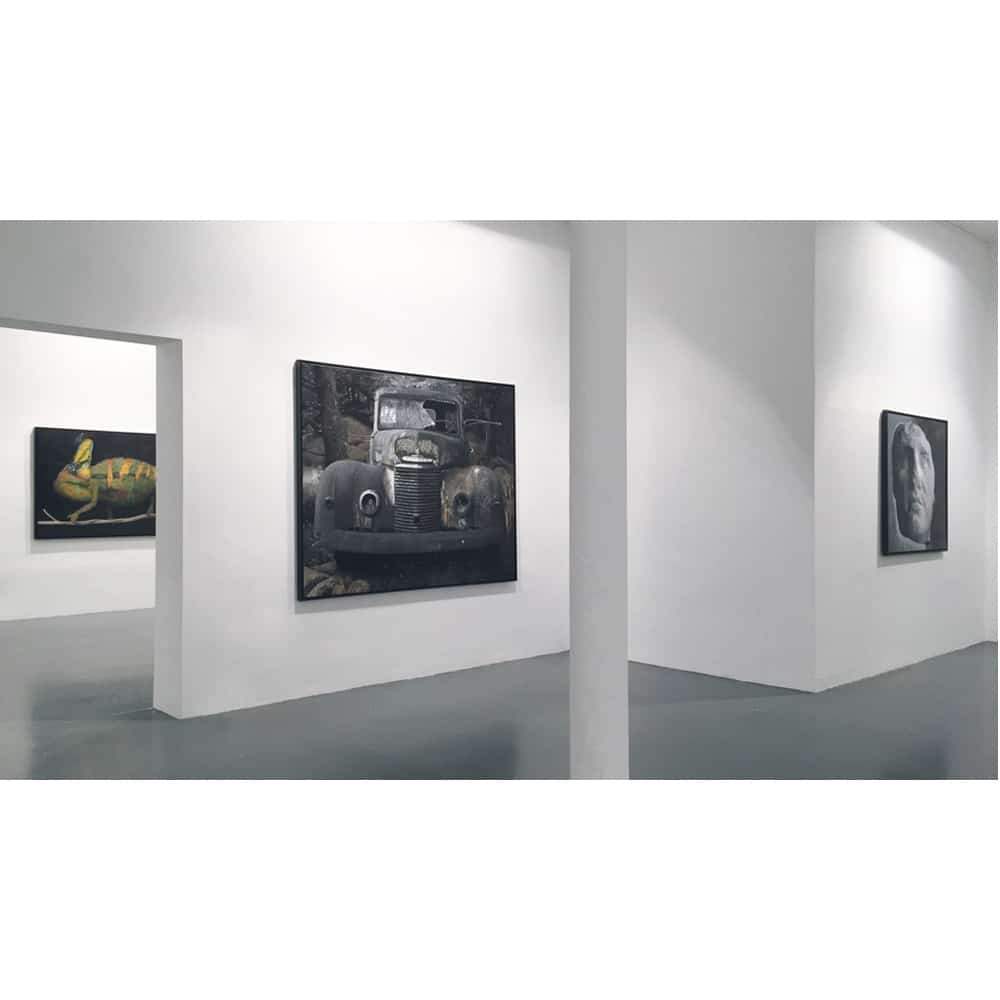

2020
1948, Salindres, France –
Lives and works in Gy-les-Nonains, France.
Odradek
Water and pigment are at once the alphabet, grammar and syntax of painting. For, and this is its difference with language, painting possesses ‘internally’ the different modes necessary for the expression of its narratives of form and colour; any constraint external to its movement dissolves in its water medium and is diluted there as soon as it shows up, conquering and tyrannical, under the banner of ut pictura poesis, or argues to impose rules or protocols. They drown in this placid lake hollowed out by Shi Tao: the rule is the absence of rule.
Christian Bonnefoi
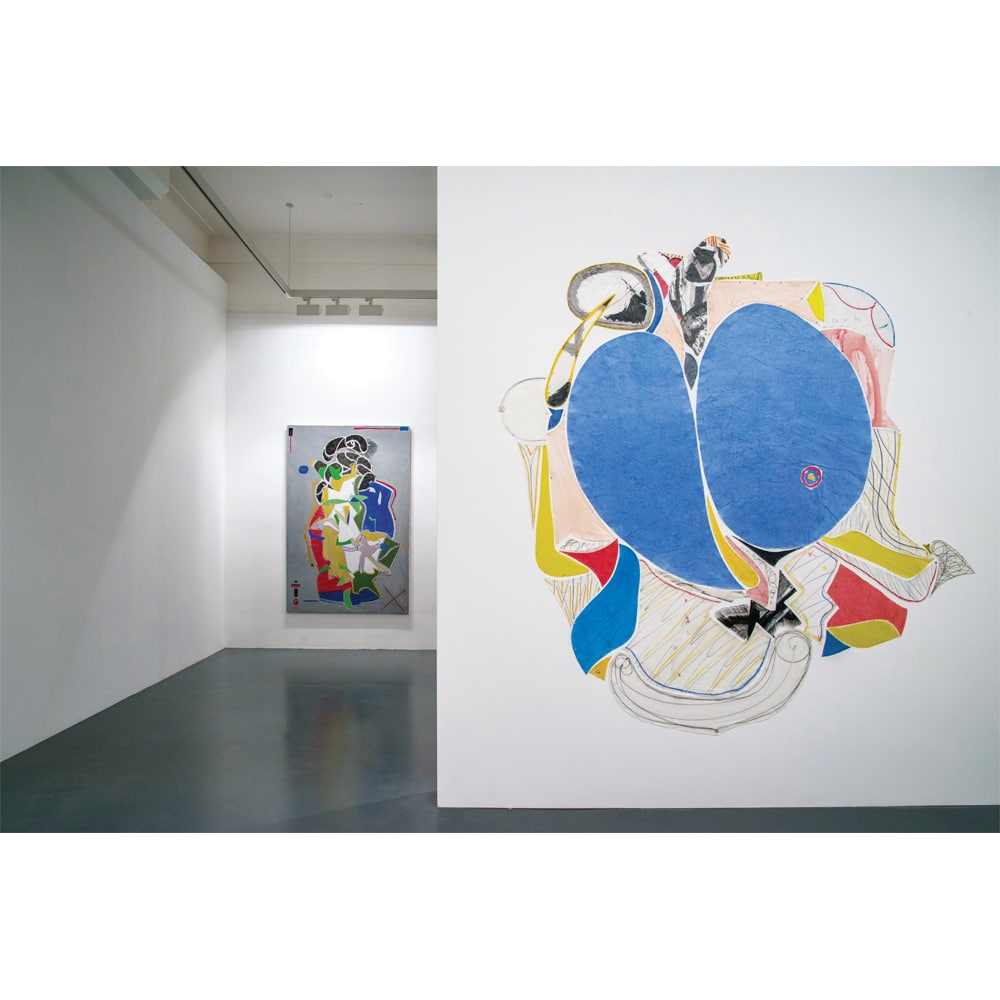
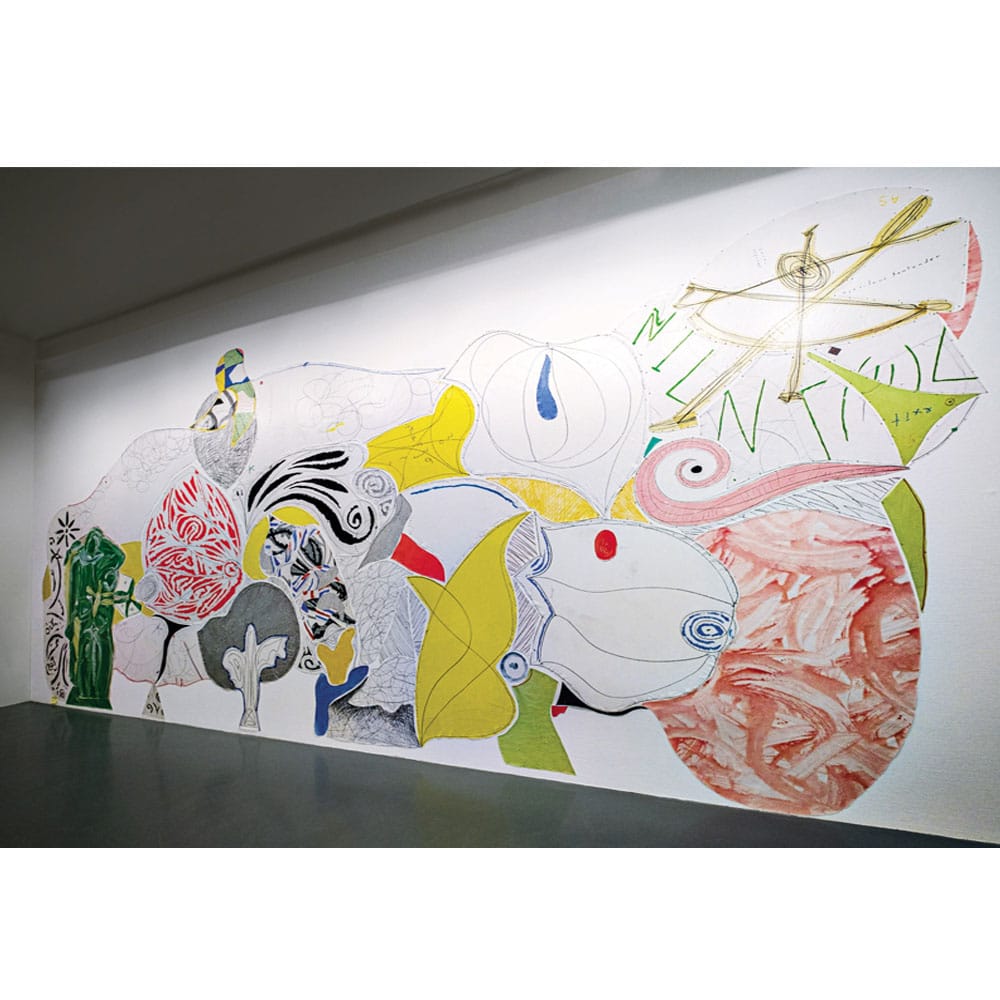
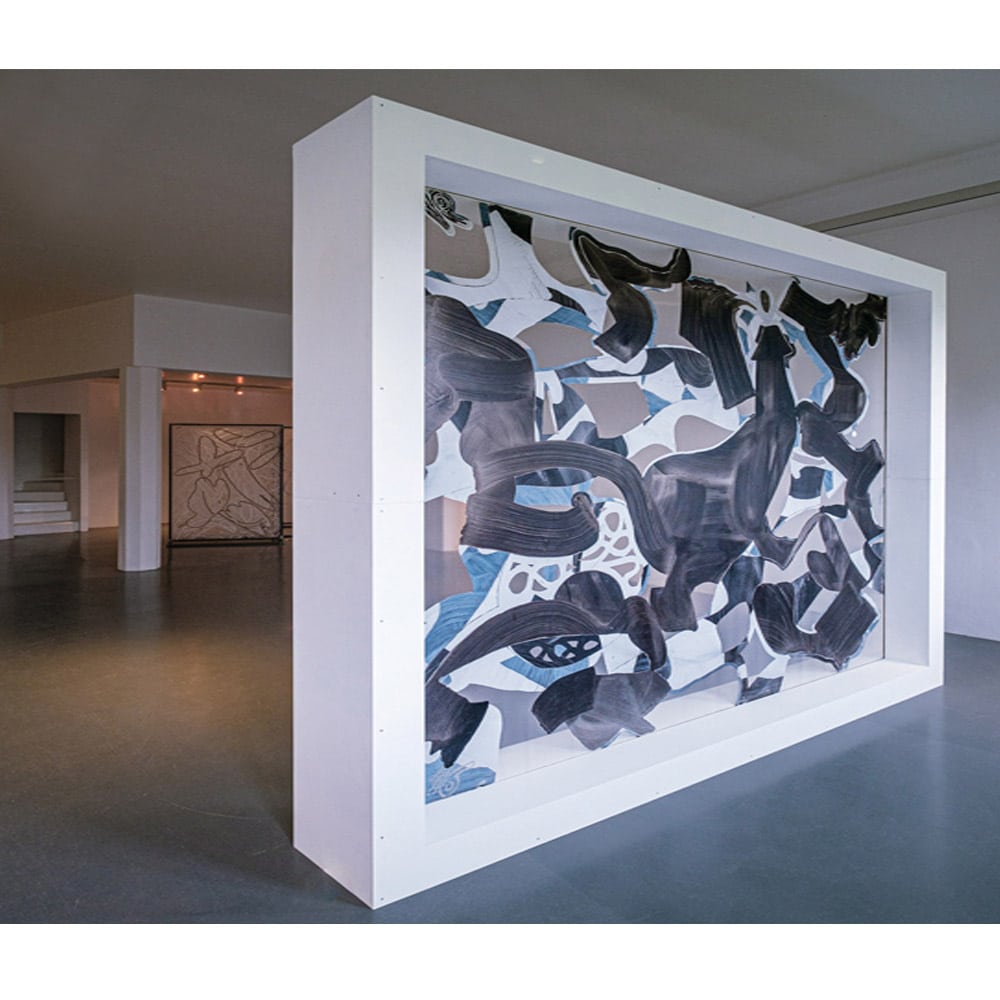

2021
1962, Paris –
Lives and works in Ivry-sur-Seine, France.
Rrose c’est la life
“The ambiguous side of the colour pink interests me: it is both soft and sharp, carrying a tender or incisive message. It refers as much to Duchamp with Rrose Selavy as to Gertrude Stein and her wonderful ‘A rose is a rose is a rose is a rose’. It is a transgender colour!
[…] In my work, I give way to ‘smoother’ works, even if they are the result of a long period of development, and to rougher works. Painting is like that! It exists – it speaks to us – in all these states. This is what enlivens the viewer when in front of it. They are not faced with a formula but with a path that offers them a variety of landscapes and various ways of approaching them.”
Agnès Thurnauer
2022
1935, Paris – 2021, Montpellier, France
Tribute to Guy de Rougemont
A member of the Académie des Beaux-Arts, Guy de Rougemont was a complete and unclassifiable artist. His colourful and playful oeuvre lies between Pop Art and Minimalism.
Advocating the decompartmentalisation of the arts, he used his painting to explore space and create environments, sculptures, decorative arts and art furniture.
Galerie Diane de Polignac
One does not pass with impunity from plane to volume, from the object to the monumental, without one day merging all of this into a single practice.
I am a painter: my sculpture, my furniture, my carpets are by a painter…
Guy de Rougemont

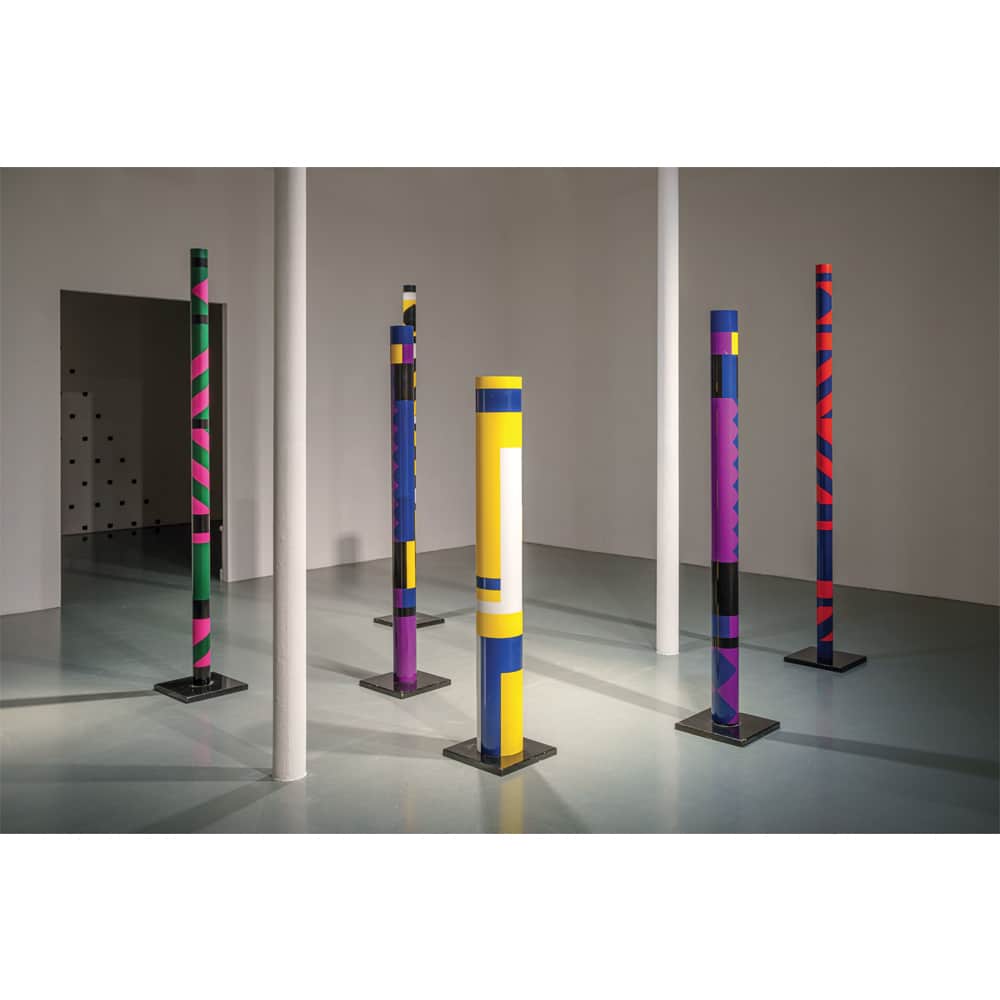

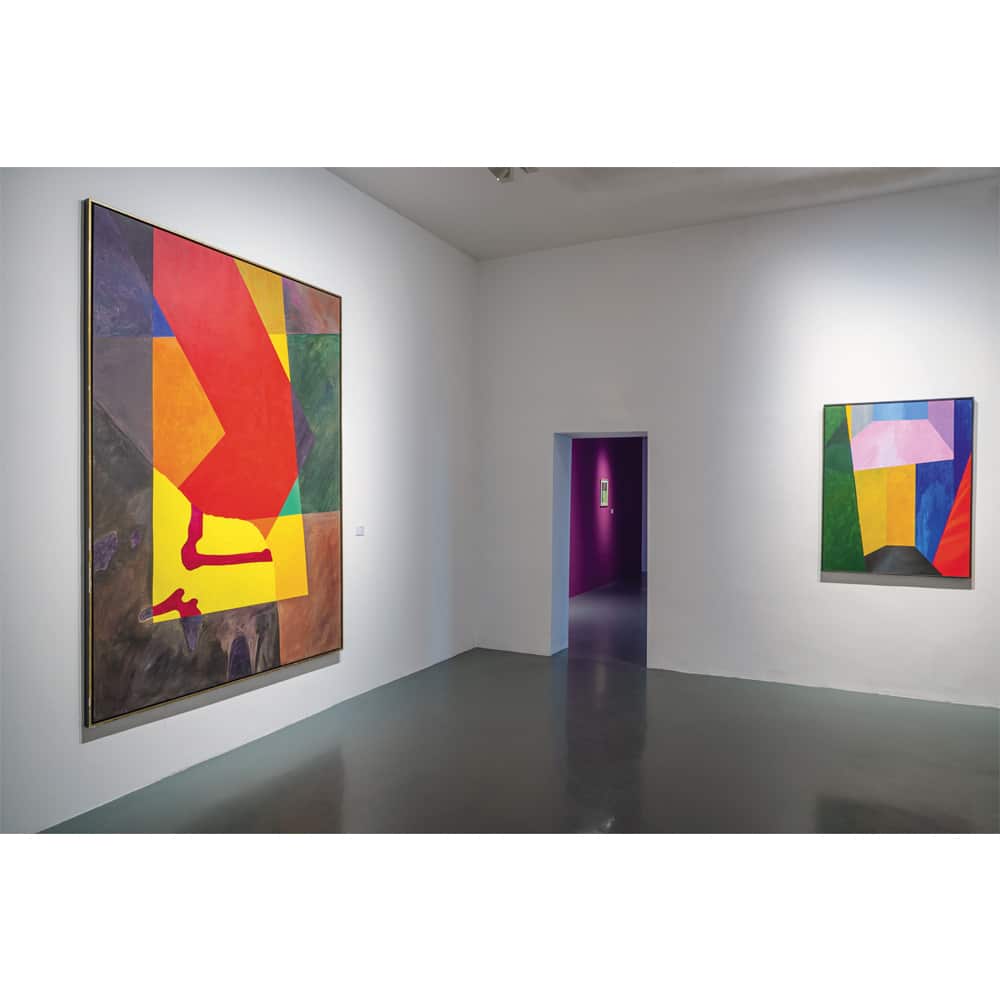
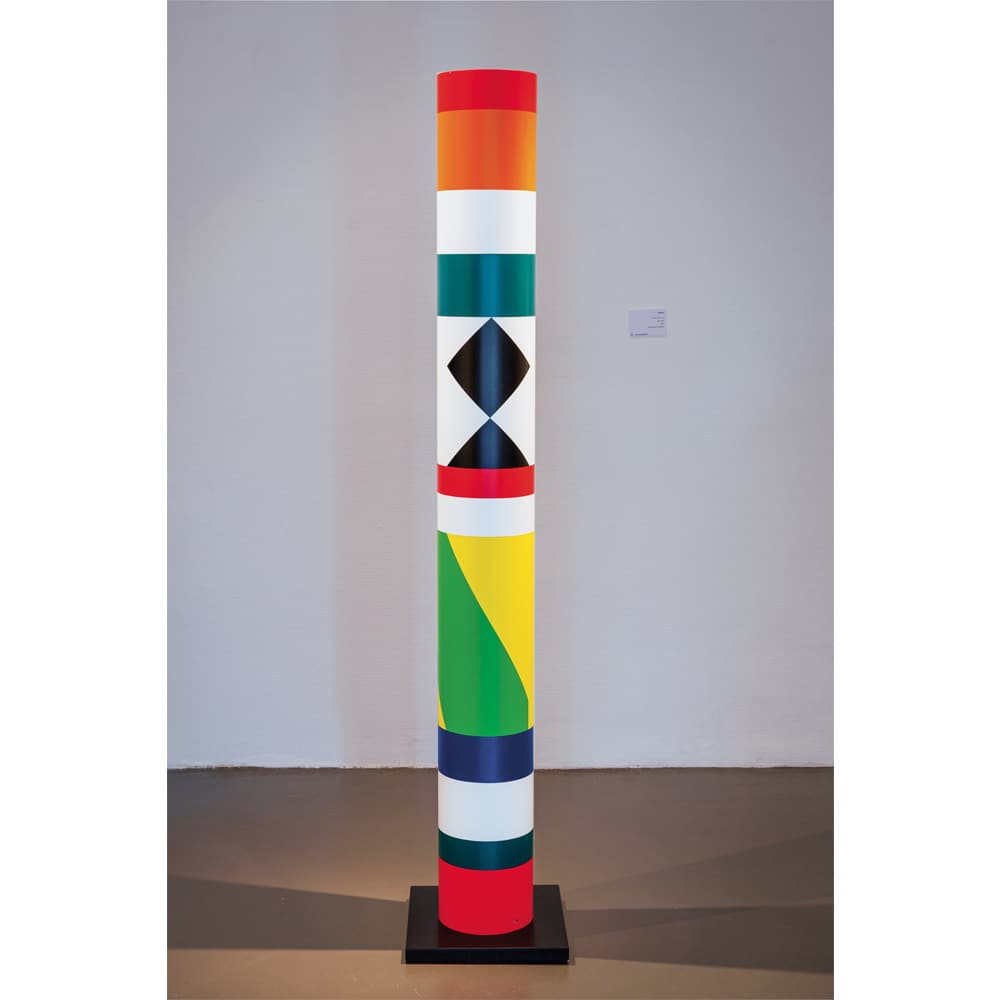
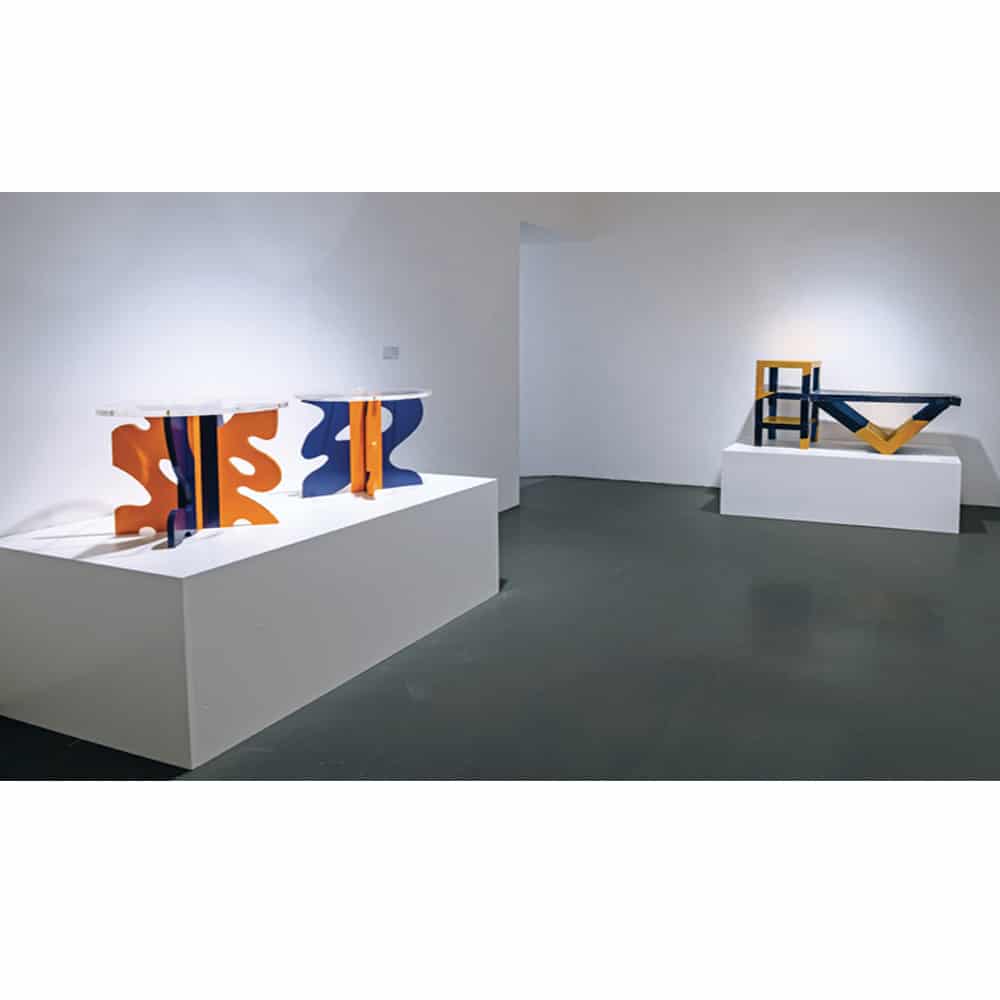
2023
Cécile Bart has designed an exhibition full of repeats and echoes, similarly to a garden with uneven plots, ranging from the vegetable patch to the tree stratum, and where certain plants would be found from place to place. A way of inhabiting a complex space, of taking the measure of its orientations, of going through it with its scansions and sequences.
A metaphor, perhaps, of her belonging and her perception of the world and nature.
The whole exhibition is made up of reminders, those in absentia, which summon up the memory of other works by the artist, and those in praesentia, which form a whole game of ricochets from room to room. More modest works, scattered here and there, reinforce these references: a Mini Farandole, Moods (pastels on paper, arranged on north-facing walls), and Films (paintings/collage or photographic posters, arranged on walls facing South). Memory.
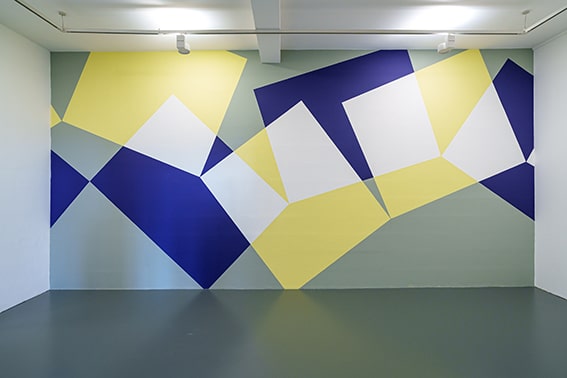
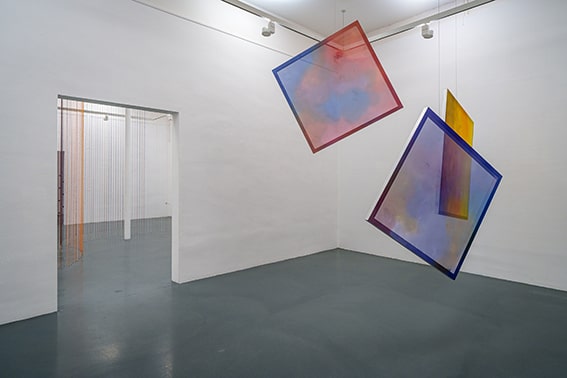
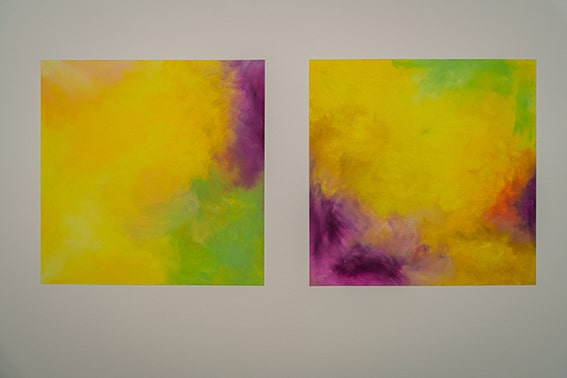
![CECILE BART 2023 copyright C.Gagneux Pixim-DSC08716[1]-min](https://centredart-bouvet-ladubay.fr/wp-content/uploads/2023/10/CECILE-BART-2023-copyright-C.Gagneux-Pixim-DSC087161-min.jpg)
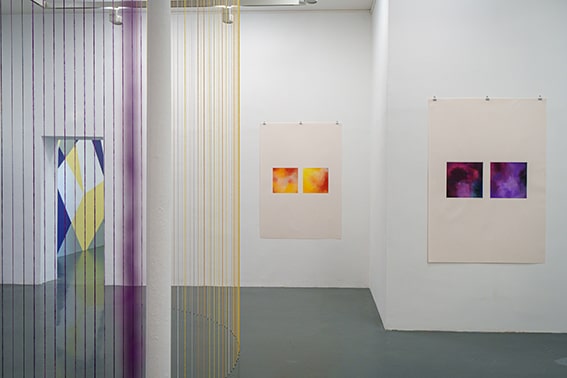
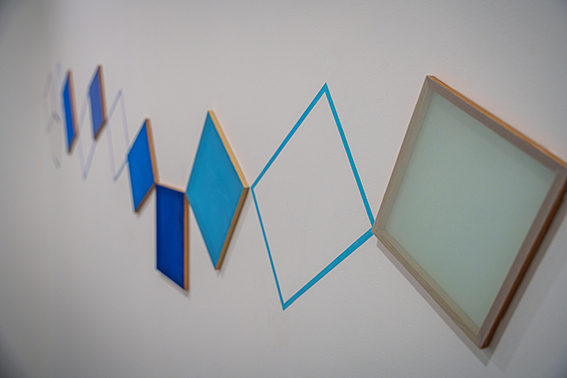
Bouvet Ladubay Contemporary Art Center
Opening hours from June 1 to September 29 2024
Newsletter
To receive our latest news, sign up for our newsletter